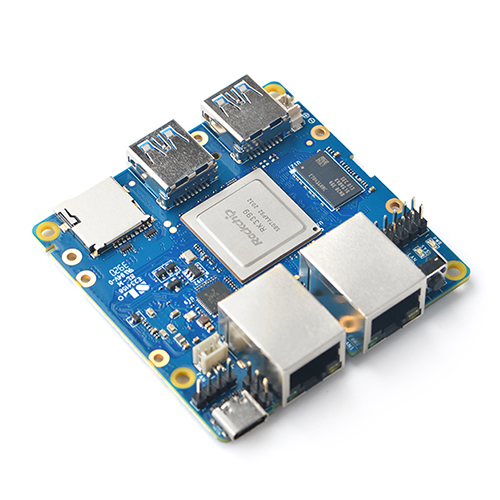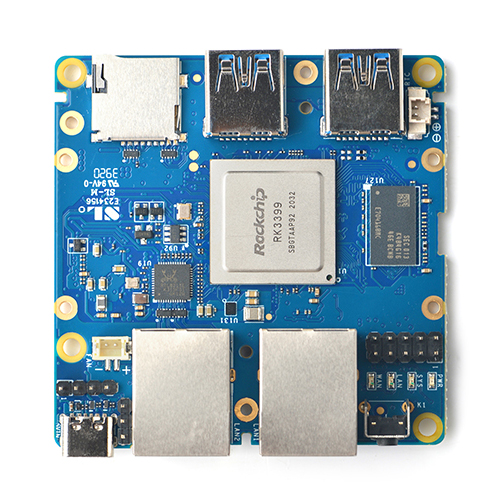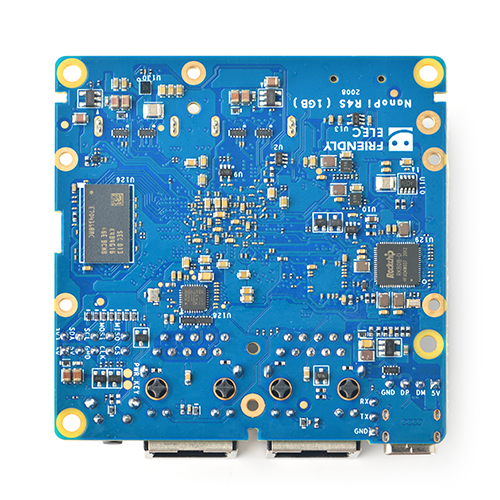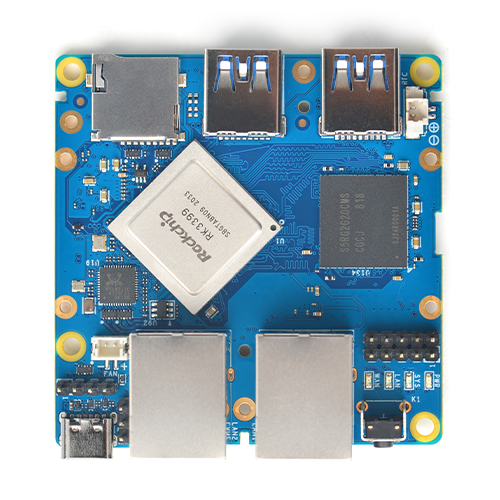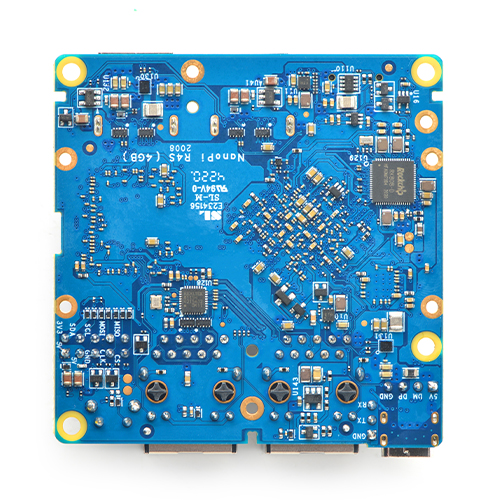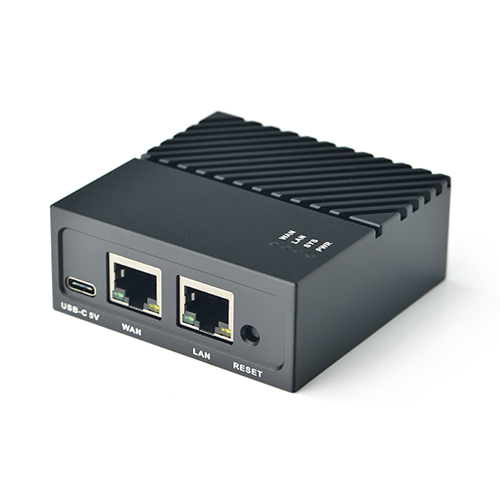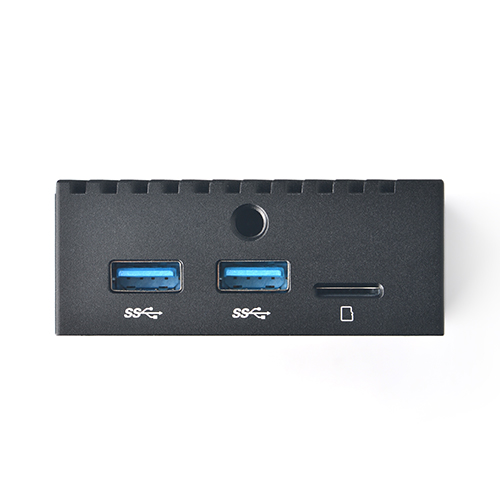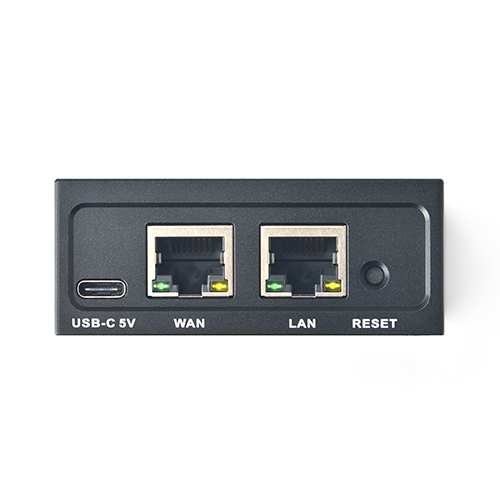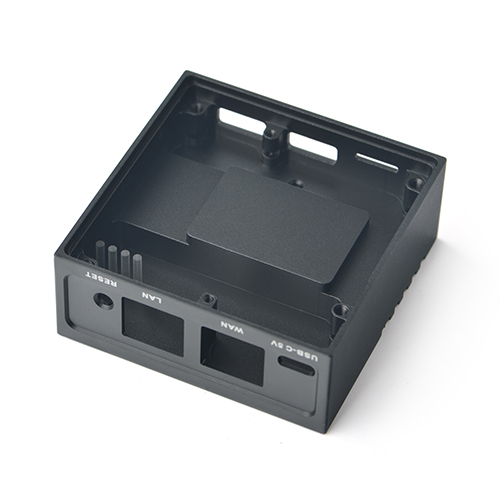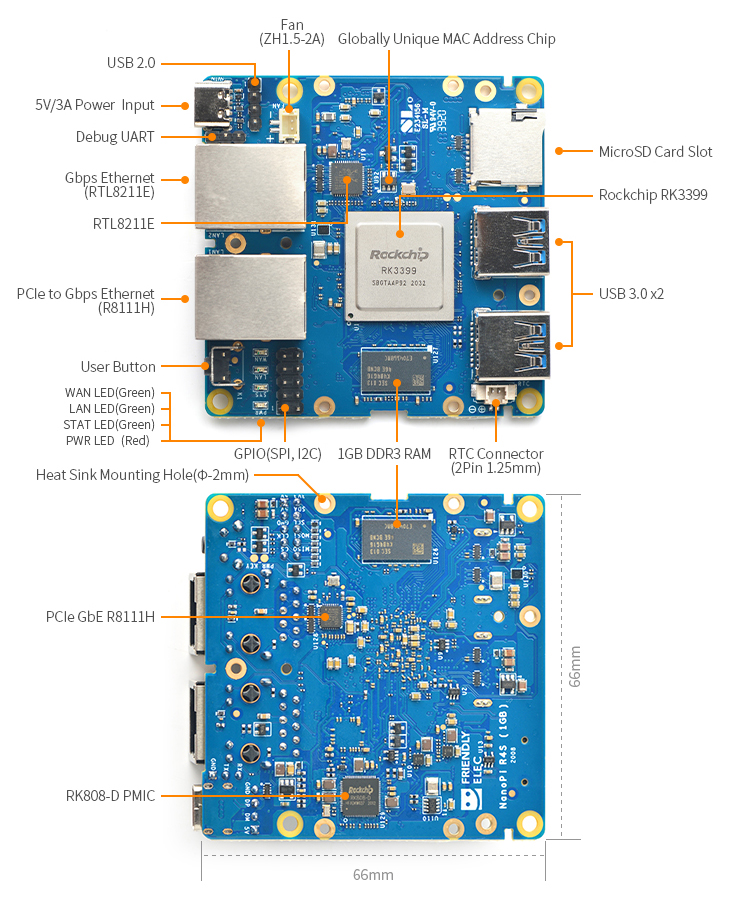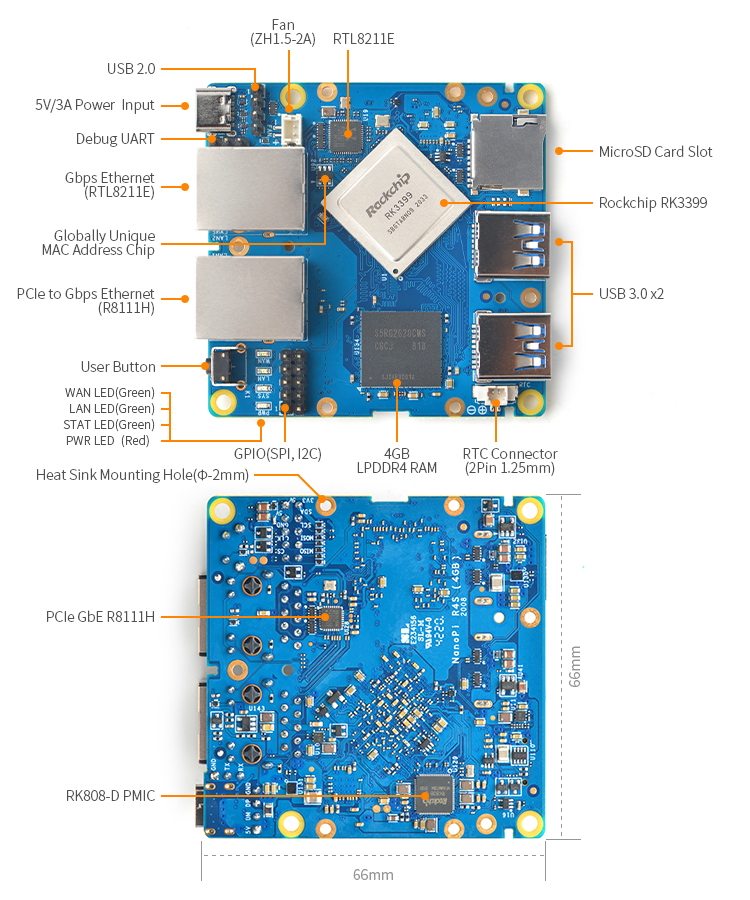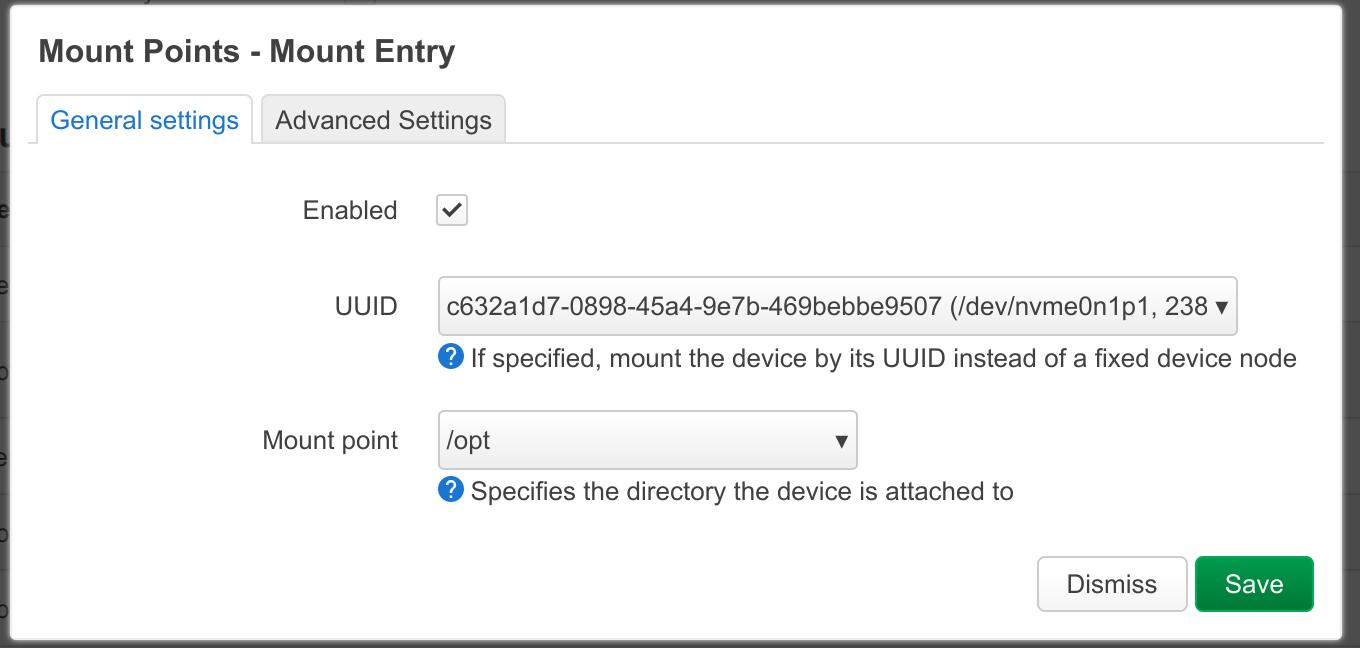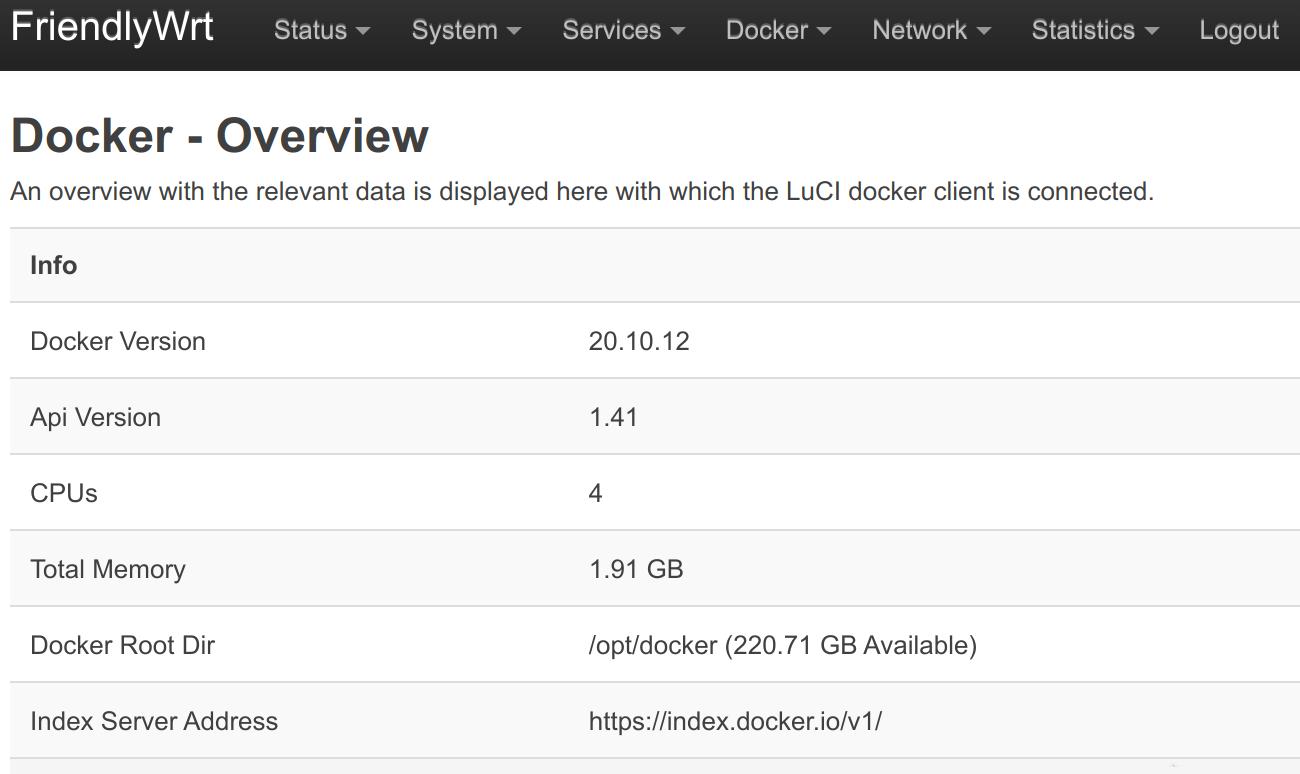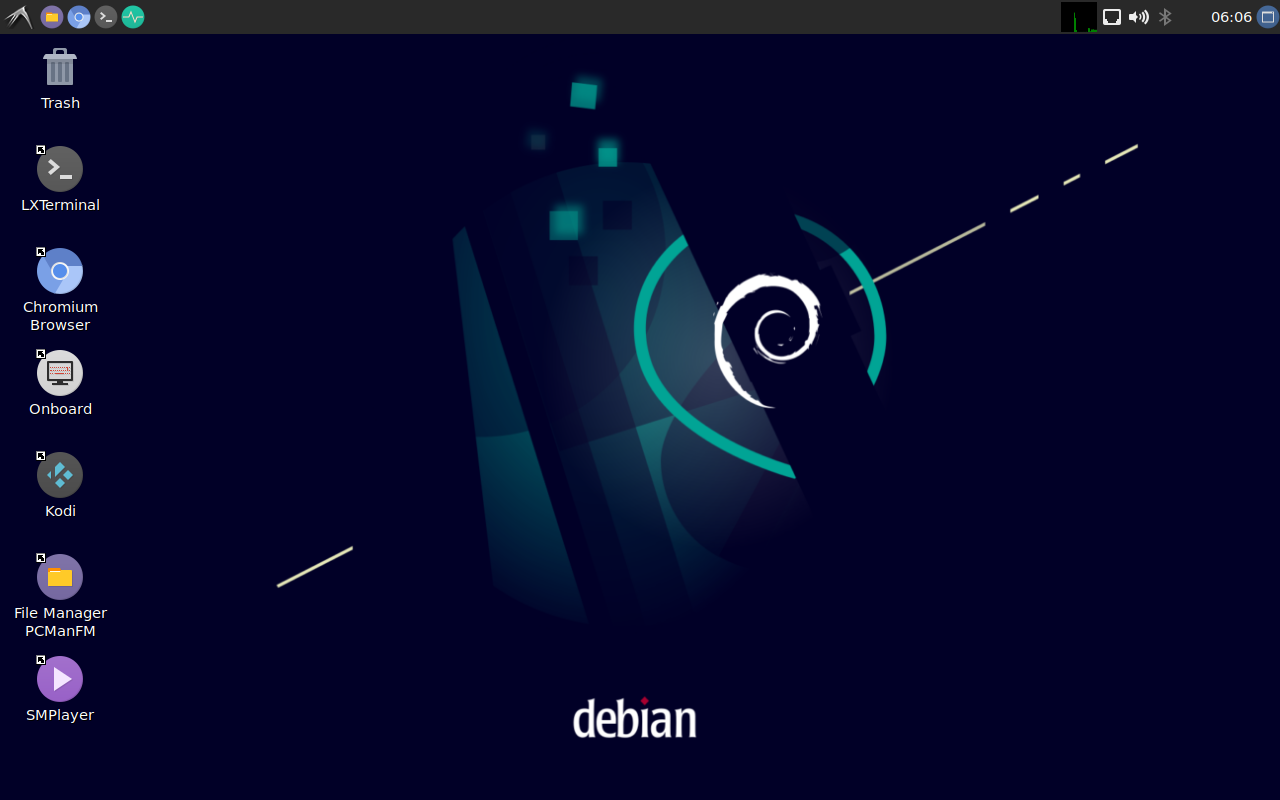Difference between revisions of "NanoPi R4S"
(updated by API) |
|||
| (78 intermediate revisions by 3 users not shown) | |||
| Line 2: | Line 2: | ||
==Introduction== | ==Introduction== | ||
| − | [[File:NanoPi_R4S- | + | [[File:NanoPi_R4S-1GB_Overview.jpg|thumb|300px|Overview]] |
| − | [[File:NanoPi_R4S- | + | [[File:NanoPi_R4S-1GB_01B.jpg|thumb|300px|Front]] |
| − | [[File:NanoPi_R4S- | + | [[File:NanoPi_R4S-1GB_Back.jpg|thumb|300px|Back]] |
| − | *The NanoPi R4S is | + | [[File:NanoPi_R4S-4GB_Front.jpg|thumb|300px|Front]] |
| − | + | [[File:NanoPi_R4S-4GB_Back.jpg|thumb|300px|Back]] | |
| + | [[File:R4SC-01.jpg|thumb|300px|Case]] | ||
| + | [[File:R4SC-02.jpg|thumb|300px|Case]] | ||
| + | [[File:R4SC-03.jpg|thumb|300px|Case]] | ||
| + | [[File:R4SC-04.jpg|thumb|300px|Case]] | ||
| + | * The NanoPi R4S(as "R4S") is an open source platform with dual-Gbps Ethernet ports designed and developed by FriendlyElec for IoT applications. | ||
| + | * The NanoPi R4S uses the RK3399 SoC. It has two Gbps Ethernet ports and 1G/4G DDR4 RAM. FriendlyElec ported an OpenWrt system for it. It works with Docker CE. It is a good platform for developing IoT applications, NAS applications etc. | ||
==Hardware Spec== | ==Hardware Spec== | ||
* SoC: Rockchip RK3399 | * SoC: Rockchip RK3399 | ||
| Line 25: | Line 31: | ||
* others: | * others: | ||
** 2 Pin 1.27/1.25mm RTC battery input connector | ** 2 Pin 1.27/1.25mm RTC battery input connector | ||
| − | ** one | + | ** one User Button |
** one 5V Fan connector | ** one 5V Fan connector | ||
* Power supply: DC 5V/3A, via USB-C connector or Pin header | * Power supply: DC 5V/3A, via USB-C connector or Pin header | ||
* PCB: 8 Layer, 66 mm x 66 mm | * PCB: 8 Layer, 66 mm x 66 mm | ||
| − | * | + | * Temperature measuring range: 0℃ to 80℃ |
==Diagram, Layout and Dimension== | ==Diagram, Layout and Dimension== | ||
===Layout=== | ===Layout=== | ||
| − | [[File:NanoPi_R4S_Layout.jpg |thumb| | + | [[File:NanoPi_R4S_Layout.jpg |thumb|300px|NanoPi R4S Layout]] |
| + | [[File:NanoPi_R4S_4GB_Layout.jpg |thumb|300px|NanoPi R4S Layout]] | ||
* '''2x5-pin header''' | * '''2x5-pin header''' | ||
::{| class="wikitable" | ::{| class="wikitable" | ||
| Line 41: | Line 48: | ||
|1 || VDD_5V ||2 || VDD_3.3V | |1 || VDD_5V ||2 || VDD_3.3V | ||
|- | |- | ||
| − | |3 || VDD_5V ||4 || I2C3_SDA | + | |3 || VDD_5V ||4 ||GPIO4_C0/I2C3_SDA(3V) |
|- | |- | ||
| − | |5 || GND ||6 || I2C3_SCL | + | |5 || GND ||6 || GPIO4_C1/I2C3_SCL(3V) |
|- | |- | ||
| − | |7 || SPI1_CLK | + | |7 || GPIO1_B1/SPI1_CLK ||8 || GPIO1_B0/SPI1_TXD/UART4-TX |
|- | |- | ||
| − | |9 || | + | |9 || GPIO1_B2/SPI1_CSn ||10 || GPIO1_A7/SPI1_RXD/UART4-RX |
|} | |} | ||
| Line 79: | Line 86: | ||
:'''Notes''' | :'''Notes''' | ||
::#Power Input : 5V/3A, via USB Type-C(USB PD Specification is not supported) or Pin1&Pin2 of the 2x5-pin header | ::#Power Input : 5V/3A, via USB Type-C(USB PD Specification is not supported) or Pin1&Pin2 of the 2x5-pin header | ||
| + | |||
| + | ===Differences Between R4S Standard Version & R4S Enterprise Version=== | ||
| + | The R4S '''Enterprise version''' has a built-in EEPROM chip (Model: 24AA025E48T) which has a globally unique MAC address. This is a permanent and temper-proof address. <br /> | ||
| + | The R4S '''Standard version''' doesn't have this chip and has a MAC address that is generated by a software utility. Apart from this difference, the two versions have the same hardware configuration.<br /> | ||
| + | <br /> | ||
| + | The Standard version doesn't have a MAC-address built-in EEPROM chip while the Enterprise version does. Both the Standard version and the Enterprise version have the same network chips (RealTek RTL8211E and R8111H). For more details please refer to the following screenshot. Retail users are recommended to choose a Standard version and enterprise users are recommended to choose an Enterprise version. <br /> | ||
| + | <br /> | ||
| + | Tips: most of the existing embedded ARM boards such as RPi 3B have MAC addresses that are generated via software utilities. This generally doesn't have impact on network communication. Globally unique MAC addresses lead to better network performance in complicated network situations and are better for large-scale enterprise applications that manage multiple network devices and operations such as IP binding. <br /> | ||
| + | <br /> | ||
| + | Position of the EEPROM Chip:<br /> | ||
| + | [[File:R4S MACchip.jpg|500px]]<br /> | ||
| + | <br /> | ||
| + | The NanoPi R4S Enterprise version has a globally unique MAC address which is by default allocated to the CPU's internal Ethernet (rtl8211e) and the name of the device is eth0. This device is named "LAN2" on the PCB and "WAN" on the board's case. This has been configured by default in FriendlyWrt.<br /> | ||
| + | Check MAC address on FriendlyWrt's website:<br /> | ||
| + | [[File:R4s-friendlywrt-macaddress.png|500px]]<br /> | ||
| + | <br /> | ||
| + | Check it in a command-line utility:<br /> | ||
| + | [[File:Friendlywrt-macaddress-ifconfig.png|500px]]<br /> | ||
| + | <br /> | ||
| + | How to check whether or not it is a globally unique MAC address: | ||
| + | * Check the first byte of the address. If bit 2 is 1, it means that this address is only used locally, not globally unique. | ||
==Get Started== | ==Get Started== | ||
| + | ===Essentials You Need=== | ||
| + | Before starting to use your NanoPi R4S get the following items ready | ||
| + | * NanoPi R4S | ||
| + | * MicroSD Card/TF Card: Class 10 or Above, minimum 8GB SDHC | ||
| + | * 5V/3A and above USB Type-C interface power adapter (Note: QC/PD fast charger may have compatibility issues), it is recommended to use the following or similar power adapter: | ||
| + | **[https://www.friendlyarm.com/index.php?route=product/product&path=73&product_id=238 5V 4A Power Adapter] | ||
| + | * If you need to develop and compile,you need a computer that can connect to the Internet. It is recommended to install Ubuntu 20.04 64-bit system and use the following script to initialize the development environment, or use docker container: <br /> | ||
| + | **[https://github.com/friendlyarm/build-env-on-ubuntu-bionic How to setup the Compiling Environment on Ubuntu bionic]<br /> | ||
| + | **[https://github.com/friendlyarm/docker-cross-compiler-novnc docker-cross-compiler-novnc]<br /> | ||
| − | == | + | ===Install OS=== |
| − | {{ | + | ====Download Image Files==== |
| + | {{BurnLinuxToSD-RK3399Router|NanoPi-R4S}} | ||
| + | {{FriendlyWrt21|NanoPi-R4S}} | ||
| + | {{OfficialUbuntuCore|NanoPi-R4S}} | ||
| + | {{FriendlyCoreRemoveQt}} | ||
| + | {{1500000SerialPortDebugSetting}} | ||
| + | ==Work with Debian11 Desktop== | ||
| + | ===Introduction to Debian11 Desktop=== | ||
| + | {{DebianBullseyeDesktop-Intro|NanoPi-R4S}} | ||
| + | {{DebianBullseyeDesktop-Common|NanoPi-R4S}} | ||
| + | ==Work with Debian10 Desktop== | ||
| + | * Refer to: | ||
| + | ** [[Debian Buster Desktop|Debian Buster]] | ||
| + | ==Buildroot Linux== | ||
| + | {{RK3399 Buildroot Intro|NanoPi-R4S}} | ||
| + | <br /> | ||
| + | For a more detailed description of the Buildroot system, please refer to: [[Buildroot|Buildroot]]<br /> | ||
| + | ==How to Compile== | ||
| + | {{Rockchip-DevEnv|NanoPi-R4S}} | ||
| + | {{RK3399-BuildFromSource|NanoPi-R4S}} | ||
| + | {{RK3399-HWAccess|NanoPi-R4S}} | ||
| + | {{RockchipMiscCustome|RK3399}} | ||
| + | {{MoreOS}} | ||
| + | ==Link to Rockchip Resources== | ||
| + | {{LinkToRockchipResources|NanoPi-R4S}} | ||
==Schematic, PCB CAD File== | ==Schematic, PCB CAD File== | ||
| − | *Schematic: [https://wiki. | + | *Schematic: [https://wiki.friendlyelec.com/wiki/images/0/06/NanoPi-R4S-1GB-2008-Schematic.pdf NanoPi-R4S-1GB-2008-Schematic.pdf] [https://wiki.friendlyelec.com/wiki/images/c/c2/NanoPi-R4S-4GB-2008-Schematic.pdf NanoPi-R4S-4GB-2008-Schematic.pdf] |
| − | *PCB CAD File:[https://wiki. | + | *PCB CAD File:[https://wiki.friendlyelec.com/wiki/images/a/ab/NanoPi_R4S_1GB_2008_dxf.zip NanoPi_R4S_1GB_2008_dxf.zip] [https://wiki.friendlyelec.com/wiki/images/1/18/NanoPi_R4S_4GB_2008_dxf.zip NanoPi_R4S_1GB_2008_dxf.zip] |
| + | ==Known Issues List== | ||
| + | ** Q: UGREEN 18W QC power adapter cannot power R4S? | ||
| + | ** A: It needs to wait for a few seconds to work normally. | ||
| + | ==Update Log== | ||
| + | {{RK3399Router-UpdateLog|NanoPi-R4S}} | ||
Latest revision as of 03:41, 20 May 2024
Contents
[hide]- 1 Introduction
- 2 Hardware Spec
- 3 Diagram, Layout and Dimension
- 4 Get Started
- 5 Work with FriendlyWrt
- 5.1 Introduction to FriendlyWrt
- 5.2 First boot
- 5.3 Account & Password
- 5.4 Login FriendlyWrt
- 5.5 Recommended security settings
- 5.6 Change LAN IP in LuCI
- 5.7 Safe shutdown operation
- 5.8 Soft Factory Reset
- 5.9 Install Software Packages
- 5.10 Disable IPv6
- 5.11 Configure the function of the user button
- 5.12 Configuring Quectel EC20 (4G module) dial-up networking
- 5.13 Some common issues of FriendlyWrt
- 5.14 Use USB2LCD to view IP and temperature
- 5.15 How to Control Fan Speed for Cooling
- 5.16 How to use USB WiFi
- 5.17 Work with Docker Applications
- 5.18 Mount smbfs
- 5.19 Use sdk to compile the package
- 5.20 Build FriendlyWrt using GitHub Actions
- 6 Work with FriendlyCore
- 7 Work with Debian11 Desktop
- 7.1 Introduction to Debian11 Desktop
- 7.2 Account & Password
- 7.3 View IP address
- 7.4 Connect to Debian via SSH
- 7.5 Update Software Packages
- 7.6 Install x11vnc Server on Debian for Remote Access
- 7.7 Install the kernel-header package
- 7.8 Change time zone
- 7.9 Change startup LOGO and Wallpaper
- 7.10 Soft Factory Reset
- 7.11 Start the program automatically at startup(For example Kodi)
- 7.12 Disable auto-mounting
- 7.13 Setup Chinese language and Input method
- 7.14 Installing Plex Multimedia Server
- 7.15 Install Docker on Debian
- 7.16 How to test NPU
- 8 Work with Debian10 Desktop
- 9 Buildroot Linux
- 10 How to Compile
- 10.1 Setup Development Environment
- 10.2 Build Openwrt/Friendlywrt
- 10.3 Build Buildroot
- 10.4 Build Other Linux
- 10.5 Build the code using scripts
- 10.6 Building AOSP from source
- 11 Using On-Board Hardware Resources
- 12 Backup rootfs and create custom SD image (to burn your application into other boards)
- 13 Configuring kernel command line parameters (only support for kernel4.4)
- 14 More OS Support
- 15 Link to Rockchip Resources
- 16 Schematic, PCB CAD File
- 17 Known Issues List
- 18 Update Log
1 Introduction
- The NanoPi R4S(as "R4S") is an open source platform with dual-Gbps Ethernet ports designed and developed by FriendlyElec for IoT applications.
- The NanoPi R4S uses the RK3399 SoC. It has two Gbps Ethernet ports and 1G/4G DDR4 RAM. FriendlyElec ported an OpenWrt system for it. It works with Docker CE. It is a good platform for developing IoT applications, NAS applications etc.
2 Hardware Spec
- SoC: Rockchip RK3399
- CPU: big.LITTLE,Dual-Core Cortex-A72(up to 2.0GHz) + Quad-Core Cortex-A53(up to 1.5GHz)
- GPU: Mali-T864 GPU,supports OpenGL ES1.1/2.0/3.0/3.1, OpenCL, DX11, and AFBC
- VPU: 4K VP9 and 4K 10bits H265/H264 60fps decoding, Dual VOP, etc
- PMU: RK808-D PMIC, cooperated with independent DC/DC, enabling DVFS, software power-down, RTC wake-up, system sleep mode
- RAM: 1GB DDR3/4GB LPDDR4
- Flash: no Onboard eMMC
- Ethernet: one Native Gigabit Ethernet, and one PCIe Gigabit Ethernet
- USB: two USB 3.0 Type-A ports
- Pin header extension interface
- 2x5-pin header: SPI x 1, I2C x 1
- 4-pin header: USB 2.0
- microSD Slot x 1
- Debug: one Debug UART, 3 Pin 2.54mm header, 3V level, 1500000bps
- LEDs: 1 x power LED and 3 x GPIO Controlled LED (SYS, LAN, WAN)
- others:
- 2 Pin 1.27/1.25mm RTC battery input connector
- one User Button
- one 5V Fan connector
- Power supply: DC 5V/3A, via USB-C connector or Pin header
- PCB: 8 Layer, 66 mm x 66 mm
- Temperature measuring range: 0℃ to 80℃
3 Diagram, Layout and Dimension
3.1 Layout
- 2x5-pin header
Pin# Assignment Pin# Assignment 1 VDD_5V 2 VDD_3.3V 3 VDD_5V 4 GPIO4_C0/I2C3_SDA(3V) 5 GND 6 GPIO4_C1/I2C3_SCL(3V) 7 GPIO1_B1/SPI1_CLK 8 GPIO1_B0/SPI1_TXD/UART4-TX 9 GPIO1_B2/SPI1_CSn 10 GPIO1_A7/SPI1_RXD/UART4-RX
- 4-pin header
1 2 3 4 VDD_5V USB_DM USB_DP GND
- Debug UART Pin Spec
- 3V level signals, 1500000bps
Pin# Assignment Description 1 GND 0V 2 UART2DBG_TX output 3 UART2DBG_RX intput
- USB Port
- Each USB 3.0 port has 2A overcurrent protection.
- RTC
- RTC backup current is 27uA.
- Connector P/N: Molex 53398-0271
- Notes
- Power Input : 5V/3A, via USB Type-C(USB PD Specification is not supported) or Pin1&Pin2 of the 2x5-pin header
3.2 Differences Between R4S Standard Version & R4S Enterprise Version
The R4S Enterprise version has a built-in EEPROM chip (Model: 24AA025E48T) which has a globally unique MAC address. This is a permanent and temper-proof address.
The R4S Standard version doesn't have this chip and has a MAC address that is generated by a software utility. Apart from this difference, the two versions have the same hardware configuration.
The Standard version doesn't have a MAC-address built-in EEPROM chip while the Enterprise version does. Both the Standard version and the Enterprise version have the same network chips (RealTek RTL8211E and R8111H). For more details please refer to the following screenshot. Retail users are recommended to choose a Standard version and enterprise users are recommended to choose an Enterprise version.
Tips: most of the existing embedded ARM boards such as RPi 3B have MAC addresses that are generated via software utilities. This generally doesn't have impact on network communication. Globally unique MAC addresses lead to better network performance in complicated network situations and are better for large-scale enterprise applications that manage multiple network devices and operations such as IP binding.
Position of the EEPROM Chip:
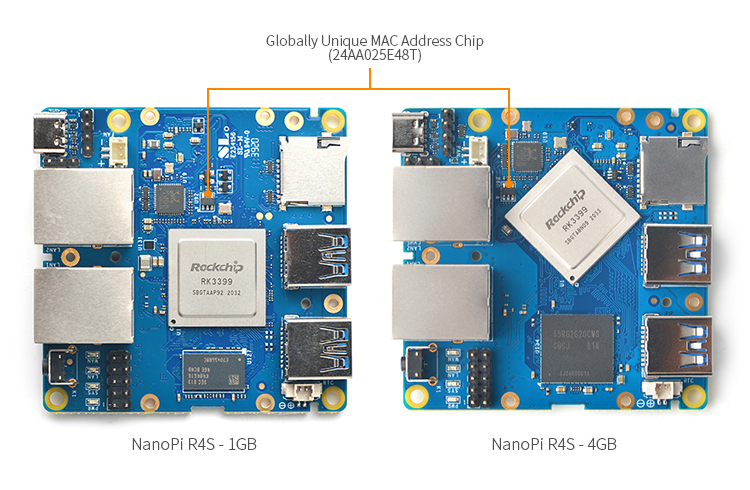
The NanoPi R4S Enterprise version has a globally unique MAC address which is by default allocated to the CPU's internal Ethernet (rtl8211e) and the name of the device is eth0. This device is named "LAN2" on the PCB and "WAN" on the board's case. This has been configured by default in FriendlyWrt.
Check MAC address on FriendlyWrt's website:
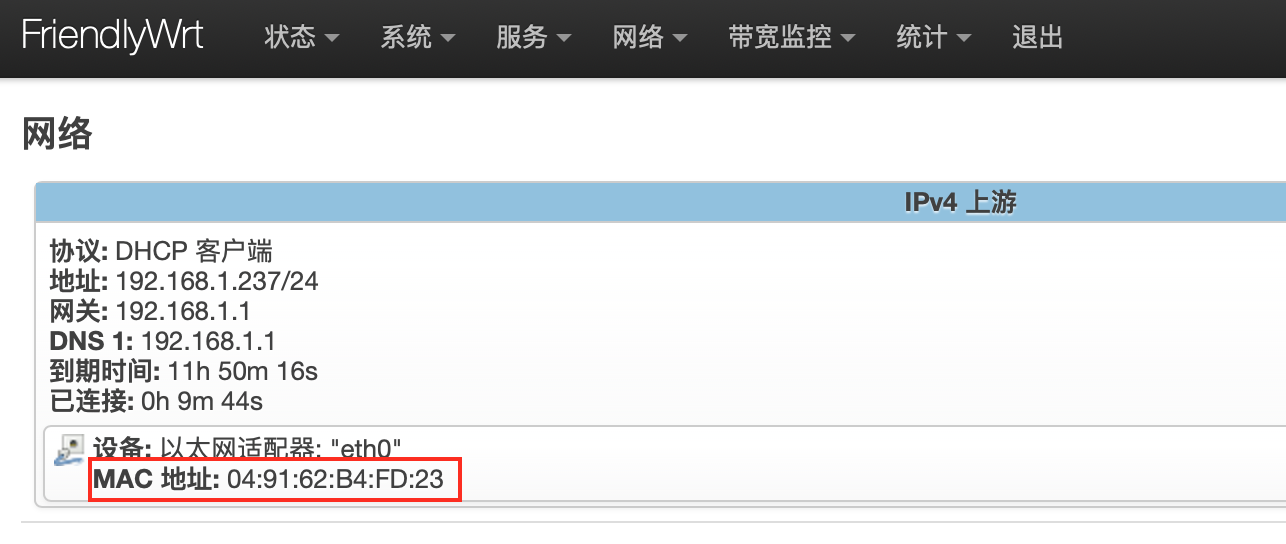
Check it in a command-line utility:
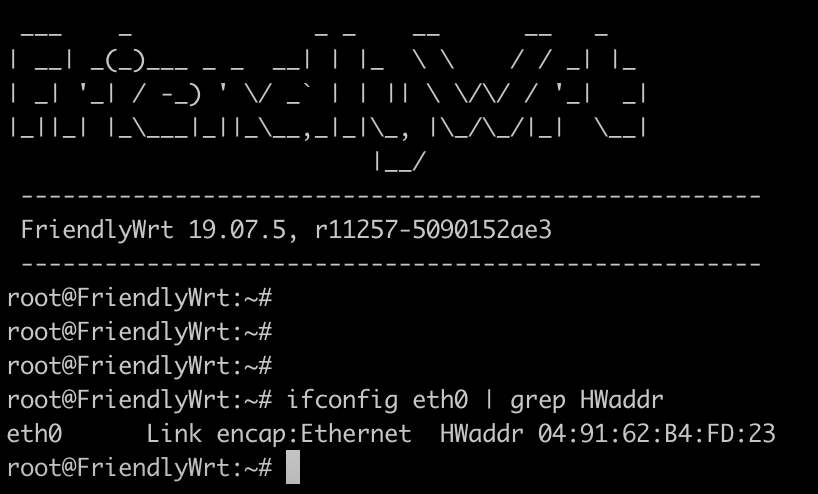
How to check whether or not it is a globally unique MAC address:
- Check the first byte of the address. If bit 2 is 1, it means that this address is only used locally, not globally unique.
4 Get Started
4.1 Essentials You Need
Before starting to use your NanoPi R4S get the following items ready
- NanoPi R4S
- MicroSD Card/TF Card: Class 10 or Above, minimum 8GB SDHC
- 5V/3A and above USB Type-C interface power adapter (Note: QC/PD fast charger may have compatibility issues), it is recommended to use the following or similar power adapter:
- If you need to develop and compile,you need a computer that can connect to the Internet. It is recommended to install Ubuntu 20.04 64-bit system and use the following script to initialize the development environment, or use docker container:
4.2 Install OS
4.2.1 Download Image Files
4.2.2 Flash to TF
Visit download linkto download image files (in the "01_Official images/01_SD card images" directory) and utilities (in the "05_Tools" directory):
| Image Files | |
| rk3399-sd-friendlywrt-24.10-YYYYMMDD.img.gz | FriendlyWrt image file, based on OpenWrt 24.10, kernel version 6.6.y |
| rk3399-sd-friendlywrt-24.10-docker-YYYYMMDD.img.gz | FriendlyWrt image file, built-in docker, based on OpenWrt 24.10, kernel version 6.6.y |
| rk3399-sd-friendlywrt-23.05-YYYYMMDD.img.gz | FriendlyWrt image file, based on OpenWrt 23.05, kernel version 6.6.y |
| rk3399-sd-friendlywrt-23.05-docker-YYYYMMDD.img.gz | FriendlyWrt image file, built-in docker, based on OpenWrt 23.05, kernel version 6.6.y |
| rk3399-sd-ubuntu-noble-core-4.19-arm64-YYYYMMDD.img.zip | Ubuntu 24.04 Core No desktop environment, command line only Kernel version 4.19.y |
| rk3399-sd-debian-bookworm-core-4.19-arm64-YYYYMMDD.img.gz | Debian 12 Core No desktop environment, command line only Kernel version 4.19.y |
| rk3399-sd-debian-bullseye-minimal-4.19-arm64-YYYYMMDD.img.gz | Debian 11(Bullseye) Desktop Uses LXDE as default desktop No pre-installed recommended software Supports hardware acceleration Kernel version 4.19.y |
| rk3399-sd-debian-bullseye-desktop-4.19-arm64-YYYYMMDD.img.gz | Debian 11(Bullseye) Desktop Uses LXDE as default desktop Pre-installed mpv, smplayer and chromium brower Supports hardware acceleration Kernel version 4.19.y |
| Other Image | |
| FriendlyWrt (Github Actions) | FriendlyWrt |
| Alpine-Linux (Github Actions) | Alpine-Linux |
| Flash Utility: | |
| win32diskimager.rar | Windows utility. Under Linux users can use "dd" |
The detailed steps are as follows:
- Get an 8G SDHC card and backup its data if necessary;
- Download and extract the xxx.img.gz and win32diskimager;
- Run the win32diskimager utility under Windows as administrator. On the utility's main window select your SD card's drive, the wanted image file and click on "write" to start flashing the SD card. Under Linux run "dd" to flash the rkXXXX-sd-OSNAME-YYYYMMDD.img file to your SD card;
- Take out the SD and insert it to NanoPi-R4S's microSD card slot;
- Power on NanoPi-R4S and it will be booted from your TF card;
5 Work with FriendlyWrt
5.1 Introduction to FriendlyWrt
FriendlyWrt is a customized system made by FriendlyElec based on an OpenWrt distribution. It is open source and well suitable for developing IoT applications, NAS applications etc.
5.2 First boot
For the first boot, the system needs to do the following initialization work:
1)Extended root file system
2)Initial setup(will execute /root/setup.sh)
So you need to wait for a while (about 2~3 minutes) to boot up for the first time, and then set FriendlyWrt, you can enter the ttyd terminal on the openwrt webpage, when the prompt is displayed as root@FriendlyWrt, it means the system has been initialized.
root@FriendlyWrt
5.3 Account & Password
The default password is password (empty password in some versions). Please set or change a safer password for web login and ssh login. It is recommended to complete this setting before connecting NanoPi-R4S to the Internet.
5.4 Login FriendlyWrt
Connect the PC to the LAN port of NanoPi-R4S. If your PC without a built-in ethernet port, connect the LAN port of the wireless AP to the LAN port of NanoPi-R4S, and then connect your PC to the wireless AP via WiFi , Enter the following URL on your PC's browser to access the admin page:
- http://friendlywrt/
- http://192.168.2.1/
- http://[fd00:ab:cd::1]
The above is the LAN port address of NanoPi-R4S. The IP address of the WAN port will be dynamically obtained from your main router through DHCP.
5.5 Recommended security settings
The following settings are highly recommended to complete before connecting NanoPi-R4S to the Internet。
- Set a secure password
- Only allow access to ssh from lan, change the port
- Check the firewall settings
Set up as you wish.
5.6 Change LAN IP in LuCI
1) Click on Network → Interfaces, then click on the Edit button of the LAN Network;
2) In General Setup tab, input new IP address (for example: 192.168.11.1), click "Save" and then click "Save & Apply";
3) On the pop-up window with the title “Connectivity change“, click "Apply and revert on connectivity loss";
4) Wait a moment, enter the new address in your computer's browser and login to FriendlyWrt;
5.7 Safe shutdown operation
Enter the "Services" -> "Terminal", enter the "poweroff" command and hit enter, wait until the led light is off, and then unplug the power supply.
5.8 Soft Factory Reset
Enter "System"->"Backup/Flash firmware",Click “Perform reset“ Button, Your device's settings will be reset to defaults like when FriendlyWrt was first installed.
You can also do this in the terminal:
firstboot && reboot5.9 Install Software Packages
5.9.1 Set up openwrt official opkg source
sed -i -e 's/mirrors.cloud.tencent.com/downloads.openwrt.org/g' /etc/opkg/distfeeds.conf opkg update
5.9.2 Update Package List
Before install software packages update the package list:
$ opkg update
5.9.3 List Available Packages
$ opkg list
5.9.4 List Installed Packages
$ opkg list-installed
5.9.5 Install Packages
$ opkg install <package names>
5.9.6 Remove Packages
$ opkg remove <package names>
5.10 Disable IPv6
. /root/setup.sh disable_ipv6 reboot
5.11 Configure the function of the user button
By default, the user button is configured to reboot the device, as shown below:
echo 'BTN_1 1 /sbin/reboot' >> /etc/triggerhappy/triggers.d/example.conf
You can change its behavior by changing the configuration file above.
5.12 Configuring Quectel EC20 (4G module) dial-up networking
- Go to "Network" -> "Interfaces"
- Click "Delete" next to "WAN6", then click "Save & Apply"
- Click "Edit" next to "WAN", in the "Device" drop-down menu, select "Ethernet Adapter: wwan0", in the "Protocol" drop-down menu, select "QMI Cellular" and click "Switch Protocol"
- Click the "Modem Device" drop-down menu, select "/dev/cdc-wdm0", fill in the APN information (e.g. for China Mobile, enter "cmnet")
- Click "Save" to close the dialog, Finally, click "Save & Apply" at the bottom of the page to initiate the dial-up process
- Devices connected to LAN will have access to the Internet, If your device has a WiFi module, you can enable wireless AP functionality on the "Wireless" page and connect to the Internet via devices connected wirelessly
5.13 Some common issues of FriendlyWrt
- Unable to dial up
- Go to "Network" -> "Firewall" and set "Inbound Data", "Outbound Data" and "Forwarding" in "WAN Zone" to "Accept";
- If you still cannot access the Internet, you can try to turn off IPV6;
- Dial-up successful, but no outgoing traffic
- Go to "Services" -> "Terminal" and type "fw4 reload" to try to reload the firewall settings again;
- Unable to power on
- Try to replace the power adapter and cable. It is recommended to use a power supply with specifications above 5V/2A;
- Note that some fast chargers with Type-C interface will have a delay, it may take a few seconds to start providing power;
- When doing secondary routing, the computer cannot connect to the Internet
- If your main network is IPv4, and NanoPi-R4S works in IPv6, the computer may not be able to connect to the Internet. It is recommended to turn off IPv6 (the method is described later in this WiKi), or switch the main route to IPv6;
- If you have questions or have better suggestions, please send an email to techsupport@friendlyarm.com;
5.14 Use USB2LCD to view IP and temperature
Plug the USB2LCD module to the USB interface ofNanoPi-R4S and power on, the IP address and CPU temperature will be displayed on the LCD:
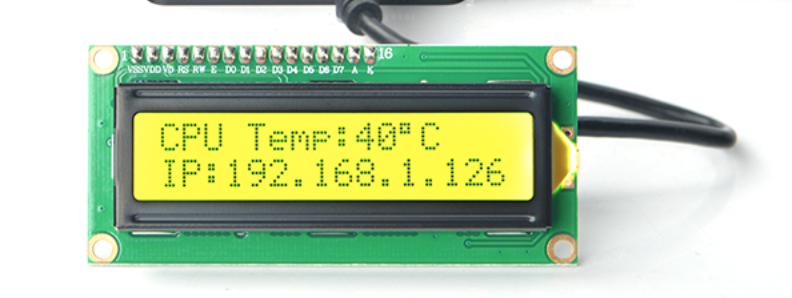
5.15 How to Control Fan Speed for Cooling
(Note: The contents of this section are based on firmware released after 2021/08/31, kernel version kernel 5.10.xyz)
- The default behavior of the current PWM fan is: after a short wait (about 20 seconds) for power on, the fan will first work automatically for about 5 seconds, after which the behavior is driven by the kernel, which decides the fan on/off and the speed according to the CPU temperature.
- The behavior of the fan can be changed by modifying the following script: /usr/bin/fa-fancontrol.sh. For example, to change the CPU temperature when the fan starts working, you can change the following two lines:
echo 50000 > trip_point_3_temp # Indicates that the fan starts working at the lowest speed when the CPU temperature reaches 50 degrees echo 55000 > trip_point_4_temp # Indicates that when the CPU temperature reaches 55 degrees, the fan rises to the second gear and above and automatically adjusts to the highest gear (4th gear) or reduces the speed according to the CPU cooling situation
- If you need to adjust the speed of each gear, you can modify the kernel dts file and recompile the kernel to achieve the purpose, the specific dts and modified location can be referred to the following commit: https://github.com/friendlyarm/kernel-rockchip/commit/f74ac319f02e2d22cdd33227e7f167e4232809f9
As shown below, the cooling-levels define 4 levels, with 0 being off and the highest level being 255:
fan: pwm-fan {
compatible = "pwm-fan";
- /* FIXME: adjust leveles for the connected fan */
- cooling-levels = <0 12 18 255>;
+ cooling-levels = <0 18 102 170 255>;- If you are using kernel version 4.19.xyz, the fan is operated by PWM at the application level to achieve temperature control, the above content is not applicable, you need to modify this script:
/usr/bin/fa-fancontrol-direct.sh
5.16 How to use USB WiFi
5.16.1 Check USB WiFi Device with Command Line Utility
(1) Click on "services>ttyd" to start the command line utility
(2) Make sure no USB devices are connected to your board and run the following command to check if any USB devices are connected or not
lsusb
(3) Connect a USB WiFi device to the board and run the command again
lsusb
You will see a new device is detected. In our test the device's ID was 0BDA:C811
(4) Type your device's ID (in our case it was "0BDA:C811" or "VID_0BDA&PID_C811") in a search engine and you may find a device that matches the ID. In our case the device we got was Realtek 8811CU.
5.16.2 Configure a USB WiFi Device as AP
(1) Connect a USB WiFi device to the NanoPi-R4S. We recommend you to use the following devices:
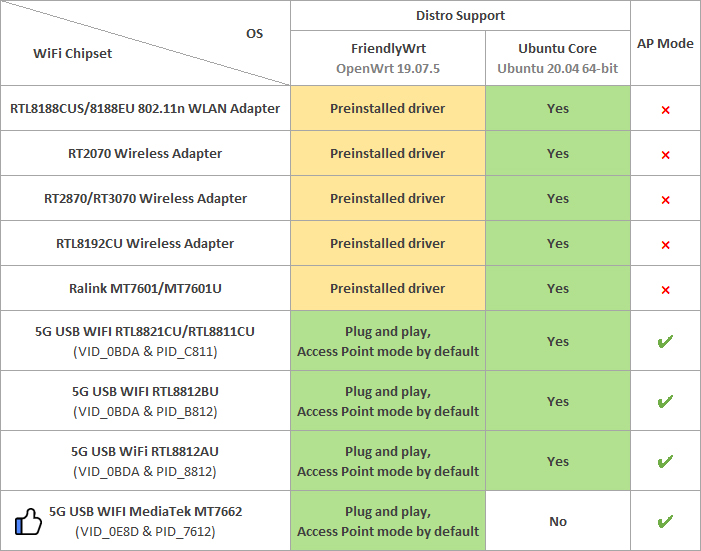
Note: devices that match these VID&PIDs would most likely work.
(2) Click on "System>Reboot" and reboot your NanoPi-R4S
(3) Click on "Network>Wireless" to enter the WiFi configuration page
(4) Click on "Edit" to edit the configuration
(5) On the "Interface Configuration" page you can set the WiFi mode and SSID, and then go to "Wireless Security" to change the password. By default the password is "password". After you make your changes click on "Save" to save
(6) After you change the settings you can use a smartphone or PC to search for WiFi
5.16.3 Common USB WiFi issues
1) It is recommended to plug in the usb wifi in the off state, then power it on, FriendlyWrt will automatically generate the configuration file /etc/config/wireless, if not, see if there is wlan0 by ifconfig -a, if there is no wlan0, usually there is no driver.
2) If ifconfig -a sees wlan0, but the hotspot is not working properly, try changing the channel and country code, an inappropriate country code can also cause the WiFi to not work.
3) Some USB WiFis (e.g. MTK MT7662) work in CD-ROM mode by default and need to be switched by usb_modeswitch, you can try to add usb_modeswitch configuration to the following directory: /etc/usb_modeswitch.d.
5.16.4 Change the default WiFi hotspot configuration
FriendlyWrt sets the country, hotspot name and other parameters for USB WiFi by default, with the aim of being as plug-and-play as possible, but this does not guarantee that all modules will be compatible with this setting, you can change these behaviors by modifying the following file:
/lib/wifi/mac80211.sh
5.17 Work with Docker Applications
5.17.1 Work with Docker: Install JellyFin
mkdir -p /jellyfin/config mkdir -p /jellyfin/videos docker run --restart=always -d -p 8096:8096 -v /jellyfin/config:/config -v /jellyfin/videos:/videos jellyfin/jellyfin:10.1.0-arm64 -name myjellyfin
After installation, visit port 8096 and here is what you would find:

5.17.2 Work with Docker: Install Personal Nextcloud
mkdir /nextcloud -p docker run -d -p 8888:80 --name nextcloud -v /nextcloud/:/var/www/html/ --restart=always --privileged=true arm64v8/nextcloud
After installtion, visit port 8888.
5.17.3 Expand Docker Storage
- Stop docker service first:
/etc/init.d/dockerd stop
- Rename the original /opt directory, create an empty /opt directory:
mv /opt /opt-old && mkdir /opt
- Format your drive as ext4, and mount it to the /opt directory:
- Enter the command "mount | grep /opt" to check the mount status:
root@FriendlyWrt:~# mount | grep /opt /dev/nvme0n1p1 on /opt type ext4 (rw,relatime) root@FriendlyWrt:~#
- Copy the files from the original /opt directory to the new /opt directory:
cp -af /opt-old/* /opt/ && rm -rf /opt-old
- Reboot the device
reboot
- After reboot, go to the "Docker" -> "Overview" page, check the information in the "Docker Root Dir" line, you can see that the Docker space has been expanded:
5.17.4 Docker FAQ and solutions
5.17.4.1 Unable to access the network services provided by the Docker container
Solution:
- Go to the "Firewall" settings and set "Forwarding" to "Accept";
- Turn off "Software Offload";
5.18 Mount smbfs
mount -t cifs //192.168.1.10/shared /movie -o username=xxx,password=yyy,file_mode=0644
5.19 Use sdk to compile the package
5.19.1 Install the compilation environment
Download and run the following script on 64-bit Ubuntu (version 18.04+): How to setup the Compiling Environment on Ubuntu bionic
5.19.2 Download and decompress sdk from the network disk
The sdk is located in the toolchain directory of the network disk:
tar xvf openwrt-sdk-*-rockchip-armv8_gcc-11.2.0_musl.Linux-x86_64.tar.xz # If the path is too long, it will cause some package compilation errors, so change the directory name here mv openwrt-sdk-*-rockchip-armv8_gcc-11.2.0_musl.Linux-x86_64 sdk cd sdk ./scripts/feeds update -a ./scripts/feeds install -a
5.19.3 Compile the package
download the source code of the example (a total of 3 examples are example1, example2, example3), and copy to the package directory:
git clone https://github.com/mwarning/openwrt-examples.git cp -rf openwrt-examples/example* package/ rm -rf openwrt-examples/
Then enter the configuration menu through the following command:
make menuconfigIn the menu, select the following packages we want to compile (actually selected by default):
"Utilities" => "example1" "Utilities" => "example3" "Network" => "VPN" => "example2"
execute the following commands to compile the three software packages:
make package/example1/compile V=99 make package/example2/compile V=99 make package/example3/compile V=99
After the compilation is successful, you can find the ipk file in the bin directory, as shown below:
$ find ./bin -name example*.ipk ./bin/packages/aarch64_generic/base/example3_1.0.0-220420.38257_aarch64_generic.ipk ./bin/packages/aarch64_generic/base/example1_1.0.0-220420.38257_aarch64_generic.ipk ./bin/packages/aarch64_generic/base/example2_1.0.0-220420.38257_aarch64_generic.ipk
5.19.4 Install the ipk to NanoPi
You can use the scp command to upload the ipk file to NanoPi:
cd ./bin/packages/aarch64_generic/base/ scp example*.ipk root@192.168.2.1:/root/
Then use the opkg command to install them:
cd /root/ opkg install example3_1.0.0-220420.38257_aarch64_generic.ipk opkg install example1_1.0.0-220420.38257_aarch64_generic.ipk opkg install example2_1.0.0-220420.38257_aarch64_generic.ipk
5.20 Build FriendlyWrt using GitHub Actions
Please refre this link: https://github.com/friendlyarm/Actions-FriendlyWrt
6 Work with FriendlyCore
6.1 FriendlyCore User Account
- Non-root User:
User Name: pi Password: pi
- Root:
User Name: root Password: fa
6.2 Update Software Packages
$ sudo apt-get update
6.3 Setup Network Configurations
6.3.1 Set static IP address
By default "eth0" is assigned an IP address obtained via dhcp. If you want to change the setting you need to change the following file:
vi /etc/network/interfaces.d/eth0
For example if you want to assign a static IP to it you can run the following commands:
auto eth0
iface eth0 inet static
address 192.168.1.231
netmask 255.255.255.0
gateway 192.168.1.16.3.2 Set a DNS
You also need to modify the following file to add the DNS configuration:
vi /etc/systemd/resolved.conf
For example, set to 192.168.1.1:
[Resolve] DNS=192.168.1.1
Restart the systemd-resolved service with the following command:
sudo systemctl restart systemd-resolved.service sudo systemctl enable systemd-resolved.service
6.3.3 Set up to use another network interface
To change the setting of "eth1" you can add a new file similar to eth0's configuration file under the /etc/network/interfaces.d/ directory.
6.4 Setup Wi-Fi
First, use the following command to check if Network-Manager is installed on your system:
which nmcliIf you have installed it, refer to this link to connect to WiFi: Use NetworkManager to configure network settings, If you do not have Network-Manager installed on your system, please refer to the following method to configure WiFi,
By default the WiFi device is "wlan0". You need to create a configuration file under "/etc/network/interfaces.d/" for WiFi:
vi /etc/network/interfaces.d/wlan0
Here is a sample wlan0 file:
auto lo
iface lo inet loopback
auto wlan0
iface wlan0 inet dhcp
wpa-driver wext
wpa-ssid YourWiFiESSID
wpa-ap-scan 1
wpa-proto RSN
wpa-pairwise CCMP
wpa-group CCMP
wpa-key-mgmt WPA-PSK
wpa-psk YourWiFiPasswordPlease replace "YourWiFiESSID" and "YourWiFiPassword" with your WiFiESSID and password. After save and close the file you can connect to your WiFi source by running the following command:
sudo systemctl daemon-reload sudo systemctl restart networking
After you power on your board it will automatically connect to your WiFi source.
Please note that if you use one TF card to boot multiple boards the WiFi device name will likely be named to "wlan1", "wlan2" and etc. You can reset it to "wlan0" by deleting the contents of the following file and reboot your board:
/etc/udev/rules.d/70-persistent-net.rules
6.4.1 WiFi models supported
6.4.1.1 M.2 WiFi Module
- RTL8822CE
6.4.1.2 Usb Dongle
- RTL8821CU (Vid: 0BDA, Pid: C811) (Test sample:TP-Link TL-WDN5200H)
- RTL8812AU (Vid: 0BDA, Pid: 8812)
- MediaTek MT7662 (Vid: 0E8D, Pid: 7612) (Test sample:COMFAST CF-WU782AC V2)
6.5 Install the kernel-header package
sudo dpkg -i /opt/archives/linux-headers-*.deb
6.6 Build kernel-header deb package
Please refre to: https://github.com/friendlyarm/sd-fuse_rk3399/blob/kernel-5.15.y/test/test-build-kernel-header-deb.sh
6.7 Config status LEDs
First determine whether the system already exists the leds initialization service:
sudo systemctl status ledsIf the leds service already exists, change the default behavior of the LEDs by editing the following file:
/etc/init.d/leds.sh
Since there is no leds service in the early firmware, you need to refer to the following guide to manually configure the LEDs. First, set the following kernel modules to be automatically loaded at boot:
modprobe ledtrig-netdev echo ledtrig-netdev > /etc/modules-load.d/ledtrig-netdev.conf
Put the following into the autorun script to associate the status leds with the ethernet interface, and you can configure it to behave in other ways by referring to these content:
echo netdev > /sys/class/leds/wan_led/trigger echo eth0 > /sys/class/leds/wan_led/device_name echo 1 > /sys/class/leds/wan_led/link echo netdev > /sys/class/leds/lan_led/trigger echo eth1 > /sys/class/leds/lan_led/device_name echo 1 > /sys/class/leds/lan_led/link
Execute the following commands:
su root cd / rm -rf usr/local/Trolltech/Qt-5.10.0-rk64one usr/local/Trolltech/Qt-5.10.0-rk64one-sdk usr/bin/setqt5env* usr/bin/qt5demo etc/qt5 rm -rf opt/{qt5-browser,Qt5_CinematicExperience,qt5-multi-screen-demo,qt5-nmapper,qt5-player,qt5-smarthome,QtE-Demo,qt5-qml-image-viewer,dual-camera}
6.9 Configure parameters for serial port
Use the following serial parameters:
| Baud rate | 1500000 |
| Data bit | 8 |
| Parity check | None |
| Stop bit | 1 |
| Flow control | None |
7 Work with Debian11 Desktop
7.1 Introduction to Debian11 Desktop
Debian11 Desktop is a light-weighted debian desktop system,it has the following features:
- Uses LXDE as default desktop;
- Mali GPU-based OpenGL support;
- Support Rockhip MPP video hard coding and hard decoding;
- Pre-installed mpv and smplayer, both support 4K video hardware decoding;
- Pre-installed Chromium browser, support vpu/gpu hardware acceleration (video hard decoding limited to h264/mp4 format);
- Compatible with Plex Server and Docker;
7.2 Account & Password
Regular Account:
User Name: pi
Password: pi
Root:
the root user account is disabled by default, you may configure the root password through the 'sudo passwd root' command.
7.3 View IP address
Since the Debian Bullseye hostname is the hardware model by default, you can use the ping command to get the IP address:ping NanoPi-R4S
7.4 Connect to Debian via SSH
Run the following commandssh pi@NanoPi-R4S
The default password is: pi
7.5 Update Software Packages
$ sudo apt-get update
7.6 Install x11vnc Server on Debian for Remote Access
7.6.1 Install x11vnc server
The following command to install x11vnc server:
sudo apt-get install x11vnc
7.6.2 Set your password
sudo x11vnc -storepasswd /etc/x11vnc.pwd
7.6.3 Setup x11vnc server with systemd auto start up
Create service configuration file:
sudo vi /lib/systemd/system/x11vnc.service
Let’s copy and paste the following configuration into our newly create service file:
[Unit] Description=Start x11vnc at startup. Requires=display-manager.service After=syslog.target network-online.target Wants=syslog.target network-online.target [Service] Type=simple ExecStart=/usr/bin/x11vnc -display :0 -forever -loop -noxdamage -repeat -rfbauth /etc/x11vnc.pwd -rfbport 5900 -shared -capslock -nomodtweak ExecStop=/usr/bin/x11vnc -R stop Restart=on-failure [Install] WantedBy=multi-user.target
The following commands to reload the systmd system and to enable and start the x11vnc service:
sudo systemctl daemon-reload sudo systemctl enable x11vnc.service sudo systemctl start x11vnc
7.6.4 Testing remote access
Start the VNC client software, input IP:5900 to connect:
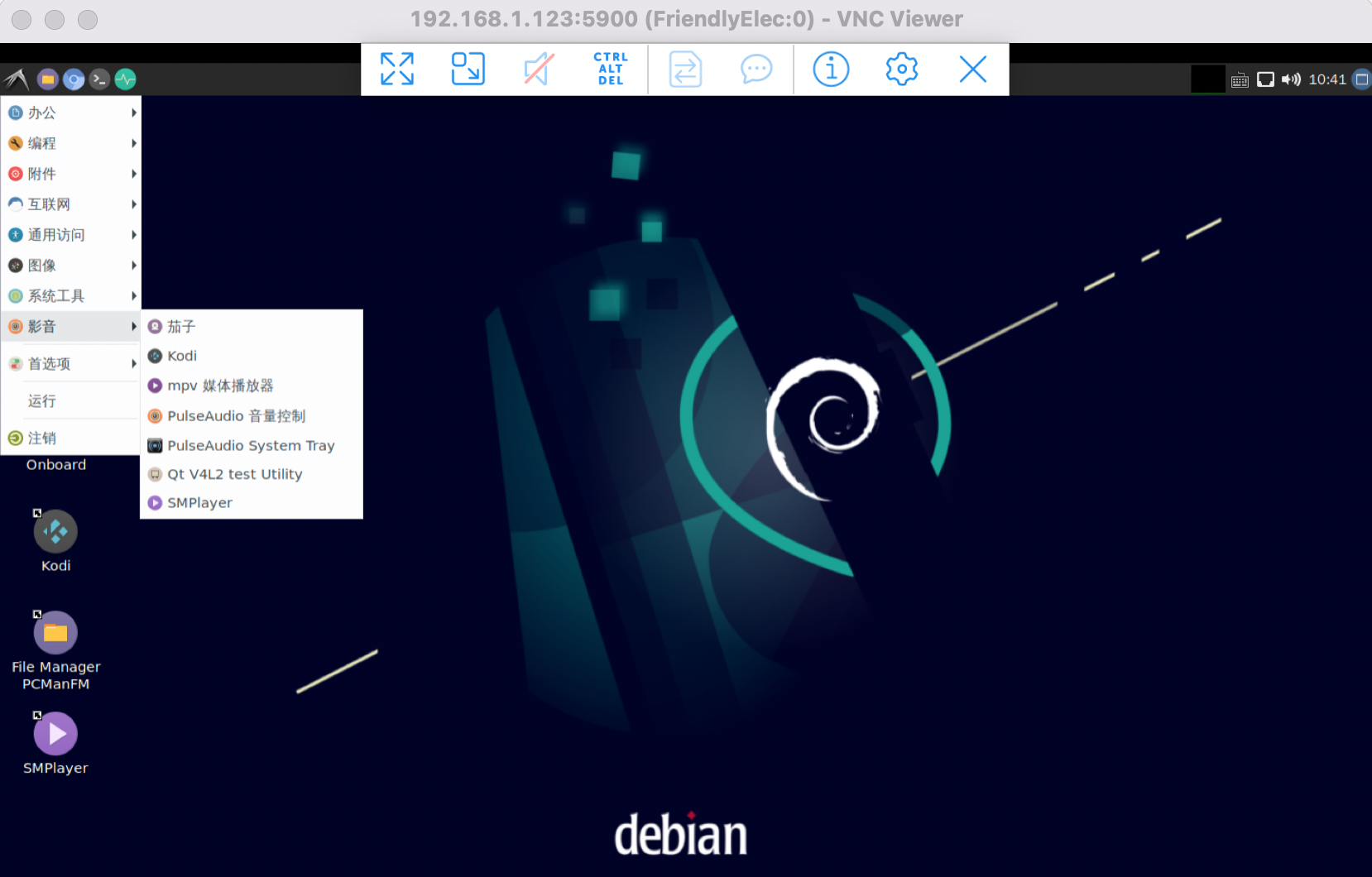
7.7 Install the kernel-header package
sudo dpkg -i /opt/archives/linux-headers-*.deb
try to compile a kernel module:
sudo apt update sudo apt install git gcc make bc git clone https://github.com/RinCat/RTL88x2BU-Linux-Driver.git cd RTL88x2BU-Linux-Driver make -j$(nproc) sudo make install sudo modprobe 88x2bu
7.8 Change time zone
7.8.1 Check the current time zone
timedatectl
7.8.2 List all available time zones
timedatectl list-timezones
7.8.3 Set the time zone (e.g. Shanghai)
sudo timedatectl set-timezone Asia/Shanghai
7.9 Change startup LOGO and Wallpaper
7.9.1 Change startup LOGO
Replace the following two files in the kernel source code directory and recompile the kernel:
kernel/logo.bmp
kernel/logo_kernel.bmp
Or use the script to operate, as shown below:
- Download scripts:
git clone https://github.com/friendlyarm/sd-fuse_rk3399.git -b kernel-4.19 --single-branch cd sd-fuse_rk3399
- Compile kernel and repackage firmware
convert files/logo.jpg -type truecolor /tmp/logo.bmp convert files/logo.jpg -type truecolor /tmp/logo_kernel.bmp sudo LOGO=/tmp/logo.bmp KERNEL_LOGO=/tmp/logo_kernel.bmp ./build-kernel.sh debian-bullseye-desktop-arm64 sudo ./mk-sd-image.sh debian-bullseye-desktop-arm64 sudo ./mk-emmc-image.sh debian-bullseye-desktop-arm64
Note: If your system is not debian-bullseye-desktop-arm64, please specify according to the actual situation
7.9.2 Change Wallpaper
Modify the following configuration file:
/home/pi/.config/pcmanfm/LXDE/desktop-items-0.conf
7.10 Soft Factory Reset
Execute the following command in a terminal:
sudo firstboot && sudo reboot
7.11 Start the program automatically at startup(For example Kodi)
Put the desktop file in the ~/.config/autostart/ directory, for example:
mkdir ~/.config/autostart/ cp /usr/share/applications/kodi.desktop ~/.config/autostart/
7.12 Disable auto-mounting
sudo systemctl mask udisks2 sudo reboot
7.13 Setup Chinese language and Input method
7.13.1 Setup Chinese language
Enter the following command and select 'zh_CN.UTF-8':
sudo dpkg-reconfigure localesAdd environment variables to .bashrc:
echo "export LC_ALL=zh_CN.UTF-8" >> ~/.bashrc echo "export LANG=zh_CN.UTF-8" >> ~/.bashrc echo "export LANGUAGE=zh_CN.UTF-8" >> ~/.bashrc
Reboot device:
sudo reboot7.13.2 Installing Chinese input method
Enter the following command to install fcitx and Pinyin input method:
sudo apt update sudo apt-get install fcitx fcitx-pinyin sudo apt-get install im-config sudo apt-get install fcitx-table* sudo apt-get install fcitx-ui-classic fcitx-ui-light sudo apt-get install fcitx-frontend-gtk2 fcitx-frontend-gtk3 fcitx-frontend-qt4 sudo apt-get remove --purge scim* ibus* sudo reboot
After reboot, press Ctrl+Space to switch between Chinese and English input methods, and the input method icon will appear in the upper right corner, right-click the input method icon in the upper right corner to switch input methods in the pop-up menu, as shown below:
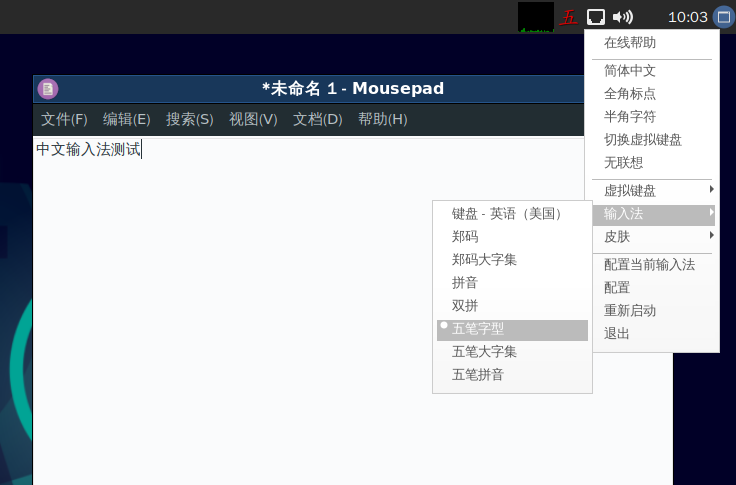
7.14 Installing Plex Multimedia Server
Visit the Plex website: https://www.plex.tv/media-server-downloads/
On the download page, select the category "Plex Media Server", choose "Linux" for the platform and "Ubuntu(16.04+)/Debian(8+) - ARMv8" for the version,
After downloading the deb package, use the dpkg command to install the package:
sudo dpkg -i plexmediaserver_1.31.0.6654-02189b09f_arm64.deb
After installation, login to the Plex server by typing the following URL into your computer browser: http://IP地址:32400/web/
7.15 Install Docker on Debian
Please refer to: How to Install Docker on Debian
7.16 How to test NPU
Please refer to: NPU
8 Work with Debian10 Desktop
- Refer to:
9 Buildroot Linux
Buildroot is a simple, efficient and easy-to-use tool to generate embedded Linux systems through cross-compilation. It contains a boot-loader, kernel, rootfs, various libraries and utilities(e.g. qt, gstreamer, busybox etc).
FriendlyELEC's Buildroot is based on Rockchip's version which is made with linux-sdk and maintained with git. FriendlyELEC's version is synced with Rockchip's version;
- Rockchip's Buildroot: https://github.com/rockchip-linux/buildroot
- Buildroot's official site: https://buildroot.org
For a more detailed description of the Buildroot system, please refer to: Buildroot
10 How to Compile
10.1 Setup Development Environment
10.1.1 Method 1: Using docker to cross-compile
Please refre to docker-cross-compiler-novnc
10.1.2 Method 2: Setup build environment on the host machine
10.1.2.1 Install required packages
Install and run requirements ubuntu 20.04, install required packages using the following commands:
sudo apt-get -y update sudo apt-get install -y sudo curl sudo bash -c \ "$(curl -fsSL https://raw.githubusercontent.com/friendlyarm/build-env-on-ubuntu-bionic/master/install.sh)"
The following cross-compilers will be installed:
| Version | Architecture | Compiler path | Purpose |
|---|---|---|---|
| 4.9.3 | armhf | /opt/FriendlyARM/toolchain/4.9.3 | Can be used to build 32-bit ARM applications |
| 6.4 | aarch64 | /opt/FriendlyARM/toolchain/6.4-aarch64 | Can be used to build kernel 4.4 |
| 11.3 | aarch64 | /opt/FriendlyARM/toolchain/11.3-aarch64 | Can be used to build kernel 4.19 or higher and U-Boot |
10.1.2.2 Setting the compiler path
Based on the table in the previous section, select the appropriate version of the compiler and add the compiler's path to PATH. For example, if you want to use the 11.3 cross-compiler, edit ~/.bashrc using vi and add the following content to the end:
export PATH=/opt/FriendlyARM/toolchain/11.3-aarch64/bin:$PATH export GCC_COLORS=auto
Run the ~/.bashrc script to make it effective in the current commandline. Note: there is a space after ".":
. ~/.bashrcTo verify if the installation was successful:
$ aarch64-linux-gcc -v Using built-in specs. COLLECT_GCC=aarch64-linux-gcc COLLECT_LTO_WRAPPER=/opt/FriendlyARM/toolchain/11.3-aarch64/libexec/gcc/aarch64-cortexa53-linux-gnu/11.3.0/lto-wrapper Target: aarch64-cortexa53-linux-gnu Configured with: /home/cross/arm64/src/gcc/configure --build=x86_64-build_pc-linux-gnu --host=x86_64-build_pc-linux-gnu --target=aarch64-cortexa53-linux-gnu --prefix=/opt/FriendlyARM/toolchain/11.3-aarch64 --exec_prefix=/opt/FriendlyARM/toolchain/11.3-aarch64 --with-sysroot=/opt/FriendlyARM/toolchain/11.3-aarch64/aarch64-cortexa53-linux-gnu/sysroot --enable-languages=c,c++ --enable-fix-cortex-a53-843419 --with-arch=armv8-a+crypto+crc --with-cpu=cortex-a53 --with-pkgversion=ctng-1.25.0-119g-FA --with-bugurl=http://www.friendlyelec.com/ --enable-objc-gc --enable-__cxa_atexit --disable-libmudflap --disable-libgomp --disable-libssp --disable-libquadmath --disable-libquadmath-support --disable-libsanitizer --disable-libmpx --with-gmp=/home/cross/arm64/buildtools --with-mpfr=/home/cross/arm64/buildtools --with-mpc=/home/cross/arm64/buildtools --with-isl=/home/cross/arm64/buildtools --enable-lto --enable-threads=posix --disable-libstdcxx-pch --enable-clocale=gnu --enable-libstdcxx-time=yes --with-default-libstdcxx-abi=new --enable-gnu-indirect-function --enable-gnu-unique-object --enable-default-pie --enable-linker-build-id --with-linker-hash-style=gnu --enable-plugin --enable-gold --with-libintl-prefix=/home/cross/arm64/buildtools --disable-multilib --with-local-prefix=/opt/FriendlyARM/toolchain/11.3-aarch64/aarch64-cortexa53-linux-gnu/sysroot --enable-long-long --enable-checking=release --enable-link-serialization=2 Thread model: posix Supported LTO compression algorithms: zlib gcc version 11.3.0 (ctng-1.25.0-119g-FA)
10.2 Build Openwrt/Friendlywrt
10.2.1 Download Code
Two versions are available, please choose as required:
10.2.1.1 FriendlyWrt 24.10
mkdir friendlywrt24-rk3399 cd friendlywrt24-rk3399 git clone https://github.com/friendlyarm/repo --depth 1 tools tools/repo init -u https://github.com/friendlyarm/friendlywrt_manifests -b master-v24.10 \ -m rk3399.xml --repo-url=https://github.com/friendlyarm/repo --no-clone-bundle tools/repo sync -c --no-clone-bundle
10.2.1.2 FriendlyWrt 23.05
mkdir friendlywrt23-rk3399 cd friendlywrt23-rk3399 git clone https://github.com/friendlyarm/repo --depth 1 tools tools/repo init -u https://github.com/friendlyarm/friendlywrt_manifests -b master-v23.05 \ -m rk3399.xml --repo-url=https://github.com/friendlyarm/repo --no-clone-bundle tools/repo sync -c --no-clone-bundle
10.2.2 First compilation step
./build.sh rk3399.mk # or rk3399-docker.mk
All the components (including u-boot, kernel, and friendlywrt) are compiled and the sd card image will be generated, then execute the following command to generate the image file for installing the system into the emmc:
./build.sh emmc-imgAfter making changes to the project, the sd card image needs to be repackaged by running the following command:
./build.sh sd-img10.2.3 Secondary compilation steps
cd friendlywrt make menuconfig rm -rf ./tmp make -j${nproc} cd ../ ./build.sh sd-img ./build.sh emmc-img
10.2.4 Build u-boot only
./build.sh uboot10.2.5 Build kernel only
./build.sh kernel10.2.6 Build friendlywrt only
./build.sh friendlywrtOr go to the friendlywrt directory and follow the standard openwrt commands. If you get an error with the above command, try using the following command to compile in a single thread:
cd friendlywrt make -j1 V=s
10.3 Build Buildroot
please refer to: Buildroot
10.4 Build Other Linux
10.4.1 Kernel and u-boot versions
| Operating System | Kernel Version | U-boot version | Cross-compiler | Partition type | Packaging Tool | Kernel branch | Kernel configuration | U-boot branch | U-boot configuration |
|---|---|---|---|---|---|---|---|---|---|
| lubuntu | linux v4.4.y | u-boot v2014.10 | 6.4-aarch64 |
MBR | sd-fuse | nanopi4-linux-v4.4.y | nanopi4_linux_defconfig | nanopi4-v2014.10_oreo | rk3399_defconfig |
| friendlycore-arm64 | |||||||||
| friendlydesktop-arm64 | |||||||||
| eflasher | |||||||||
| buildroot | linux v4.19.y | u-boot v2017.09 |
11.3-aarch64 | GPT | sd-fuse | nanopi4-v4.19.y | nanopi4_linux_defconfig | nanopi4-v2017.09 | nanopi4_defconfig |
| ubuntu-focal-desktop-arm64 | |||||||||
| debian-bullseye-desktop-arm64 | |||||||||
| debian-bullseye-minimal-arm64 | |||||||||
| friendlycore-focal-arm64 | |||||||||
| debian-bookworm-core-arm64 | |||||||||
| ubuntu-noble-core-arm64 | |||||||||
| openmediavault-arm64 | linux v6.1.y | u-boot v2017.09 |
11.3-aarch64 | GPT | sd-fuse |
nanopi-r2-v6.1.y |
nanopi4_linux_defconfig | ||
| friendlywrt21 | GPT | nanopi4_linux_defconfig +friendlywrt.config | |||||||
| friendlywrt21-docker | |||||||||
| friendlywrt23 | |||||||||
| friendlywrt23-docker |
- Kernel git repo:https://github.com/friendlyarm/kernel-rockchip
- U-boot git repo:https://github.com/friendlyarm/uboot-rockchip
- The cross-compile toolchain is located in the path: /opt/FriendlyARM/toolchain/
- The SD-Fuse is a helper script to make bootable SD card image.
- Click on MBR and GPT in the table to view the partition layout (configuration file) for each system.
10.4.2 Build kernel linux-v4.4.y
This section applies to the following operating systems:
| lubuntu | eflasher | friendlydesktop-arm64 | friendlycore-arm64 |
Clone the repository to your local drive then build:
git clone https://github.com/friendlyarm/kernel-rockchip --single-branch --depth 1 -b nanopi4-linux-v4.4.y kernel-rockchip cd kernel-rockchip export PATH=/opt/FriendlyARM/toolchain/6.4-aarch64/bin/:$PATH touch .scmversion # Load configuration make ARCH=arm64 CROSS_COMPILE=aarch64-linux- nanopi4_linux_defconfig # Optionally, if you want to change the default kernel config # make ARCH=arm64 CROSS_COMPILE=aarch64-linux- menuconfig # Start building kernel make ARCH=arm64 CROSS_COMPILE=aarch64-linux- nanopi4-images -j$(nproc) # Start building kernel modules mkdir -p out-modules make ARCH=arm64 CROSS_COMPILE=aarch64-linux- INSTALL_MOD_PATH="$PWD/out-modules" modules -j$(nproc) make ARCH=arm64 CROSS_COMPILE=aarch64-linux- INSTALL_MOD_PATH="$PWD/out-modules" modules_install KERNEL_VER=$(make CROSS_COMPILE=aarch64-linux-gnu- ARCH=arm64 kernelrelease) rm -rf $PWD/out-modules/lib/modules/${KERNEL_VER}/kernel/drivers/gpu/arm/mali400/ [ ! -f "$PWD/out-modules/lib/modules/${KERNEL_VER}/modules.dep" ] && depmod -b $PWD/out-modules -E Module.symvers -F System.map -w ${KERNEL_VER} (cd $PWD/out-modules && find . -name \*.ko | xargs aarch64-linux-strip --strip-unneeded)
After the compilation, the following files will be generated:
| kernel.img | resource.img | The kernel modules are located in the out-modules directory |
Run your build:
Please refre to #Running the build
10.4.3 Build u-boot v2014.10
This section applies to the following operating systems:
| lubuntu | eflasher | friendlydesktop-arm64 | friendlycore-arm64 |
Clone the repository to your local drive then build:
git clone https://github.com/friendlyarm/uboot-rockchip --single-branch --depth 1 -b nanopi4-v2014.10_oreo cd uboot-rockchip export PATH=/opt/FriendlyARM/toolchain/6.4-aarch64/bin/:$PATH make CROSS_COMPILE=aarch64-linux- rk3399_defconfig make CROSS_COMPILE=aarch64-linux-
After the compilation, the following files will be generated:
| uboot.img | trust.img | rk3399_loader_v1.22.119.bin (aka MiniLoaderAll.bin) |
Installing the u-boot:
Please refre to #Running the build
10.4.4 Build kernel linux-v4.19.y
This section applies to the following operating systems:
| ubuntu-focal-desktop-arm64 | debian-bullseye-desktop-arm64 | debian-bullseye-minimal-arm64 | friendlycore-focal-arm64 | ubuntu-noble-core-arm64 | debian-bookworm-core-arm64 | buildroot |
Clone the repository to your local drive then build:
git clone https://github.com/friendlyarm/kernel-rockchip --single-branch --depth 1 -b nanopi4-v4.19.y kernel-rockchip cd kernel-rockchip export PATH=/opt/FriendlyARM/toolchain/11.3-aarch64/bin/:$PATH touch .scmversion # Configuring the Kernel # Load default configuration make ARCH=arm64 CROSS_COMPILE=aarch64-linux- nanopi4_linux_defconfig # Optionally, load configuration for FriendlyWrt # make ARCH=arm64 CROSS_COMPILE=aarch64-linux- nanopi4_linux_defconfig friendlywrt.config # Optionally, if you want to change the default kernel config # make ARCH=arm64 CROSS_COMPILE=aarch64-linux- menuconfig # Start building kernel make ARCH=arm64 CROSS_COMPILE=aarch64-linux- nanopi4-images -j$(nproc) # Start building kernel modules mkdir -p out-modules make ARCH=arm64 CROSS_COMPILE=aarch64-linux- INSTALL_MOD_PATH="$PWD/out-modules" modules -j$(nproc) make ARCH=arm64 CROSS_COMPILE=aarch64-linux- INSTALL_MOD_PATH="$PWD/out-modules" modules_install KERNEL_VER=$(make CROSS_COMPILE=aarch64-linux-gnu- ARCH=arm64 kernelrelease) rm -rf $PWD/out-modules/lib/modules/${KERNEL_VER}/kernel/drivers/gpu/arm/mali400/ [ ! -f "$PWD/out-modules/lib/modules/${KERNEL_VER}/modules.dep" ] && depmod -b $PWD/out-modules -E Module.symvers -F System.map -w ${KERNEL_VER} (cd $PWD/out-modules && find . -name \*.ko | xargs aarch64-linux-strip --strip-unneeded)
After the compilation, the following files will be generated:
| kernel.img | resource.img | The kernel modules are located in the out-modules directory |
Run your build:
Please refre to #Running the build
10.4.5 Build kernel linux-v6.1.y
This section applies to the following operating systems:
| friendlywrt21 | friendlywrt21-docker | friendlywrt23 | friendlywrt23-docker | openmediavault-arm64 |
Clone the repository to your local drive then build:
git clone https://github.com/friendlyarm/kernel-rockchip --single-branch --depth 1 -b nanopi-r2-v6.1.y kernel-rockchip cd kernel-rockchip export PATH=/opt/FriendlyARM/toolchain/11.3-aarch64/bin/:$PATH touch .scmversion # Configuring the Kernel # Load default configuration make CROSS_COMPILE=aarch64-linux-gnu- ARCH=arm64 nanopi4_linux_defconfig # Optionally, load configuration for FriendlyWrt # make CROSS_COMPILE=aarch64-linux-gnu- ARCH=arm64 nanopi4_linux_defconfig friendlywrt.config # Optionally, if you want to change the default kernel config # make CROSS_COMPILE=aarch64-linux-gnu- ARCH=arm64 menuconfig # Start building kernel make CROSS_COMPILE=aarch64-linux-gnu- ARCH=arm64 -j$(nproc) # Start building kernel modules mkdir -p out-modules && rm -rf out-modules/* make CROSS_COMPILE=aarch64-linux-gnu- ARCH=arm64 INSTALL_MOD_PATH="$PWD/out-modules" modules -j$(nproc) make CROSS_COMPILE=aarch64-linux-gnu- ARCH=arm64 INSTALL_MOD_PATH="$PWD/out-modules" modules_install KERNEL_VER=$(make CROSS_COMPILE=aarch64-linux-gnu- ARCH=arm64 kernelrelease) [ ! -f "$PWD/out-modules/lib/modules/${KERNEL_VER}/modules.dep" ] && depmod -b $PWD/out-modules -E Module.symvers -F System.map -w ${KERNEL_VER} (cd $PWD/out-modules && find . -name \*.ko | xargs aarch64-linux-strip --strip-unneeded)
Pack the kernel.img and resource.img:
wget https://raw.githubusercontent.com/friendlyarm/sd-fuse_rk3399/kernel-6.1.y/tools/mkkrnlimg && chmod 755 mkkrnlimg wget https://raw.githubusercontent.com/friendlyarm/sd-fuse_rk3399/kernel-6.1.y/tools/resource_tool && chmod 755 resource_tool wget https://raw.githubusercontent.com/friendlyarm/sd-fuse_rk3399/kernel-6.1.y/prebuilt/boot/logo.bmp wget https://raw.githubusercontent.com/friendlyarm/sd-fuse_rk3399/kernel-6.1.y/prebuilt/boot/logo_kernel.bmp ./mkkrnlimg arch/arm64/boot/Image kernel.img mkdir kernel-dtbs cp -f arch/arm64/boot/dts/rockchip/rk3399-nanopi-r4s.dtb kernel-dtbs/rk3399-nanopi4-rev09.dtb cp -f arch/arm64/boot/dts/rockchip/rk3399-nanopi-r4s.dtb kernel-dtbs/rk3399-nanopi4-rev0a.dtb cp -f arch/arm64/boot/dts/rockchip/rk3399-nanopi-r4se.dtb kernel-dtbs/rk3399-nanopi4-rev0b.dtb cp -f arch/arm64/boot/dts/rockchip/rk3399-nanopc-t4.dtb kernel-dtbs/rk3399-nanopi4-rev00.dtb ./resource_tool --dtbname kernel-dtbs/*.dtb logo.bmp logo_kernel.bmp
After the compilation, the following files will be generated:
| kernel.img | resource.img | The kernel modules are located in the out-modules directory |
Run your build:
Please refre to #Running the build
10.4.6 Build u-boot v2017.09
This section applies to the following operating systems:
| ubuntu-focal-desktop-arm64 | debian-bullseye-desktop-arm64 | debian-bullseye-minimal-arm64 | friendlycore-focal-arm64 | ubuntu-noble-core-arm64 | debian-bookworm-core-arm64 | buildroot |
Clone the repository to your local drive then build:
git clone https://github.com/friendlyarm/rkbin --single-branch --depth 1 -b friendlyelec git clone https://github.com/friendlyarm/uboot-rockchip --single-branch --depth 1 -b nanopi4-v2017.09 export PATH=/opt/FriendlyARM/toolchain/11.3-aarch64/bin/:$PATH cd uboot-rockchip/ ./make.sh nanopi4
After the compilation, the following files will be generated:
| uboot.img | trust.img | rk3399_loader_v1.24.126.bin (aka MiniLoaderAll.bin) |
Run your build:
Please refre to #Running the build
10.4.7 Running the build
10.4.7.1 Install to target board
10.4.7.1.1 MBR partition
This section applies to the following operating systems:
| lubuntu | eflasher | friendlydesktop-arm64 | friendlycore-arm64 |
The MBR partitioning is only used by the Linux v4.4 kernel. You can check the partition layout by clicking on this link: partmap. To write an image file, you can use the dd command. For example, in the parameter.template file, "0x00014000@0x00014000(kernel)" specifies that the kernel partition starts at 0x00014000, which is equivalent to 81920 in decimal. Therefore, the dd command should be as follows:
dd if=kernel.img of=/dev/mmcblk0 seek=81920
10.4.7.1.2 GPT partition
This section applies to the following operating systems:
| ubuntu-focal-desktop-arm64 | debian-bookworm-core-arm64 | debian-bullseye-desktop-arm64 | debian-bullseye-minimal-arm64 |
| friendlycore-focal-arm64 | ubuntu-noble-core-arm64 | friendlywrt21-kernel4 | buildroot |
| friendlywrt21 | friendlywrt21-docker | friendlywrt23 | friendlywrt23-docker |
The OS uses GPT partitions by default which is using the Linux v4.19 and Linux v5.15 kernel, you can use the dd command, but be careful to choose the right output device:
- The SD/TF Card device node: /dev/mmcblk0
- The eMMC device node: /dev/mmcblk2
The following is an example of how to update the kernel to eMMC:
Use the 'parted' command to view the partition layout:
parted /dev/mmcblk2 print
Sample outputs:
Model: MMC BJTD4R (sd/mmc) Disk /dev/mmcblk2: 31.3GB Sector size (logical/physical): 512B/512B Partition Table: gpt Disk Flags: Number Start End Size File system Name Flags 1 8389kB 12.6MB 4194kB uboot 2 12.6MB 16.8MB 4194kB trust 3 16.8MB 21.0MB 4194kB misc 4 21.0MB 25.2MB 4194kB dtbo 5 25.2MB 41.9MB 16.8MB resource 6 41.9MB 83.9MB 41.9MB kernel 7 83.9MB 134MB 50.3MB boot 8 134MB 2500MB 2366MB ext4 rootfs 9 2500MB 31.3GB 28.8GB ext4 userdata
as shown above, the resource partition is located at 5 and the kernel partition is located at 6. Use the dd command to write the resource.img and kernel.img files to these partitions, the commands are as follows:
dd if=resource.img of=/dev/mmcblk2p5 bs=1M dd if=kernel.img of=/dev/mmcblk2p6 bs=1M
If you want to update u-boot:
dd if=uboot.img of=/dev/mmcblk2p1 bs=1M
To update new driver modules, copy the newly compiled driver modules to the appropriate directory under /lib/modules.
10.4.7.2 Packaging and creating an SD image
To create a new OS image file, you need to use the "sd-fuse" packaging tool.
"sd-fuse" is a collection of scripts that can be used to create bootable SD card images for FriendlyElec boards. Its main features include:
- Creation of root filesystem images from a directory
- Building of bootable SD card images
- Simple compilation of kernel, U-Boot, and third-party drivers
Please click on the following link to find out more:
| Kernel version | Packaging Tool |
|---|---|
| linux v4.4.y | sd-fuse |
| linux v4.19.y | sd-fuse_rk3399/kernel-4.19 |
| linux v6.1.y | sd-fuse_rk3399/kernel-6.1.y |
10.4.7.3 USB flashing
Note: kernel v4.4.y is not supported
10.4.7.3.1 Linux
Reboot the board and enter loader mode with the following command:
sudo reboot loaderTo flash U-Boot and kernel using the "upgrade_tool_v2.17_for_linux" tool, please use the following command:
sudo upgrade_tool di -k kernel.img sudo upgrade_tool di -re resource.img sudo upgrade_tool di -u uboot.img sudo upgrade_tool RD
Note: "upgrade_tool" is a command-line tool provided by Rockchip for Linux operating systems (Linux_Upgrade_Tool).
10.5 Build the code using scripts
10.5.1 Download scripts and image files
git clone https://github.com/friendlyarm/sd-fuse_rk3399.git -b kernel-4.19 cd sd-fuse_rk3399 wget http://112.124.9.243/dvdfiles/RK3399/images-for-eflasher/friendlycore-focal-arm64-images.tgz tar xvzf friendlycore-focal-arm64-images.tgz
10.5.2 Compile the kernel
Download the kernel source code and compile it. the relevant image files in the friendlycore-focal-arm64 directory will be automatically updated, including the kernel modules in the file system:
git clone https://github.com/friendlyarm/kernel-rockchip --depth 1 -b nanopi4-v4.19.y kernel-rk3399 KERNEL_SRC=$PWD/kernel-rk3399 ./build-kernel.sh friendlycore-focal-arm64
10.5.3 Compile the kernel headers
git clone https://github.com/friendlyarm/kernel-rockchip --depth 1 -b nanopi4-v4.19.y kernel-rk3399 MK_HEADERS_DEB=1 BUILD_THIRD_PARTY_DRIVER=0 KERNEL_SRC=$PWD/kernel-rk3399 ./build-kernel.sh friendlycore-focal-arm64
10.5.4 Compile the uboot
Download the uboot source code and compile it. the relevant image files in the friendlycore-focal-arm64 directory will be automatically updated:
git clone https://github.com/friendlyarm/uboot-rockchip --depth 1 -b nanopi4-v2017.09 UBOOT_SRC=$PWD/uboot-rockchip ./build-uboot.sh friendlycore-focal-arm64
10.5.5 Generate new image
Repackage the image file in the friendlycore-focal-arm64 directory into sd card image:
./mk-sd-image.sh friendlycore-focal-arm64After the command is completed, the image is in the out directory, you can use the dd command to make the SD boot card, for example:
dd if=out/rk3399-sd-friendlycore-focal-4.19-arm64-YYYYMMDD.img of=/dev/sdX bs=1M
10.6 Building AOSP from source
10.6.1 Hardware and Software Requirements
- Your computer should have at least 16GB of RAM and 300GB of disk space. We recommend using a machine with 32GB of RAM and a large-capacity, high-speed SSD, and we do not recommend using virtual machines.
- If you encounter compilation errors, they may be caused by problems with the compilation environment. We recommend using the following Docker container for compilation: docker-cross-compiler-novnc.
10.6.2 Compile Android10
10.6.2.1 Download Android10 Source Code
There are two ways to download the source code:
- repo archive file on netdisk
Netdisk URL: Click here
File location on netdisk:"07_Source codes/rk3399-android-10.git-YYYYMMDD.tar.xz" (YYYYMMDD means the date of packaging)
After extracting the repo package from the network disk, you need to execute the sync.sh script, which will pull the latest code from gitlab:
tar xf "/path/to/netdisk/07_Source codes/rk3399-android-10.git-YYYYMMDD.tar.xz" cd rk3399-android-10 ./sync.sh
- git clone from gitlab
NanoPi-R4S source code is maintained in gitlab, You can download it by running the following command:
git clone --recursive https://gitlab.com/friendlyelec/rk3399-android-10.git -b main
Note: If the following error "error: unknown option `recurse-submodules'" appears, please upgrade git to v2.0.0 or above.
10.6.2.2 Generate Image File
You can compile an Android source code and generate an image file (non-root user is recommended):
cd rk3399-android-10 ./build-nanopc-t4.sh -F -M
If you need to include google apps, you need to set an environment variable and then compile, as shown below:
cd rk3399-android-10 export INSTALL_GAPPS_FOR_TESTING=yes ./build-nanopc-t4.sh -F -M
10.6.2.3 Make OTA Packages
If you need the support of A/B (Seamless) System Updates, you need to do the following:
a) Build your own update server for http download of update files;
b) Customize the Updater application, the code is located in packages/apps/Updater, let it connect and download file from your server;
c) Use the quick compilation script parameter -O or --ota to compile OTA Packages, as shown below:
cd rk3399-android-10 ./build-nanopc-t4.sh -F -O -M
After the compilation is successfully completed, the OTA update related packages are located in the directory: rockdev/otapackage/ ,Please do not delete this directory.
After you have made some changes, compiling again with the parameter -O will generate ota-update-XXXXXXXX.zip, which is an incremental update package.
OTA Packages decides whether to generate incremental update package according to BUILD_NUMBER, for details, please refer to build-nanopc-t4.sh.
To disable the A/B feature, you can refer to the following to modify device/rockchip/rk3399/nanopc-t4/BoardConfig.mk, and then recompile uboot and android:
BOARD_USES_AB_IMAGE := false
10.6.2.4 Update System with New Image
After compilation is done a new image file will be generated in the "rockdev/Image-nanopc_t4/" directory under Android 10's source code directory. You can follow the steps below to update the OS in NanoPi-R4S:
1) Insert an SD card which is processed with EFlasher to an SD card reader and insert this reader to a PC running Ubuntu. The SD card's partitions will be automatically mounted;
2) Copy all the files under the "rockdev/Image-nanopc_t4/" directory to the SD card's android10 directory in the "FRIENDLYARM" partition;
3) Insert this SD card to NanoPi-R4S and reflash Android
When flashing Android 10, EFlasher requires v1.3 or above. When flashing with Type-C, please use the tool AndroidTool v2.71 or Linux_Upgrade_Tool v1.49 provided by Rockchip.
10.6.3 Compile Android8.1
10.6.3.1 Download Android8.1 Source Code
There are two ways to download the source code:
- repo archive file on netdisk
Netdisk URL: Click here
File location on netdisk:sources/rk3399-android-8.1.git-YYYYMMDD.tgz (YYYYMMDD means the date of packaging)
After extracting the repo package from the network disk, you need to execute the sync.sh script, which will pull the latest code from gitlab:
tar xvzf /path/to/netdisk/sources/rk3399-android-8.1.git-YYYYMMDD.tgz cd rk3399-android-8.1 ./sync.sh
- git clone from gitlab
NanoPi-R4S source code is maintained in gitlab, You can download it by running the following command:
git clone https://gitlab.com/friendlyelec/rk3399-android-8.1 --depth 1 -b master
10.6.3.2 Generate Image File
You can compile an Android source code and generate an image file:
cd rk3399-android-8.1 ./build-nanopc-t4.sh -F -M
10.6.3.3 Update System with New Image
After compilation is done a new image file will be generated in the "rockdev/Image-nanopc_t4/" directory under Android 8.1's source code directory. You can follow the steps below to update the OS in NanoPi-R4S:
1) Insert an SD card which is processed with EFlasher to an SD card reader and insert this reader to a PC running Ubuntu. The SD card's partitions will be automatically mounted;
2) Copy all the files under the "rockdev/Image-nanopc_t4/" directory to the SD card's android8 directory in the "FRIENDLYARM" partition;
3) Insert this SD card to NanoPi-R4S and reflash Android
Here is an alternative guide to update OS: sd-fuse_rk3399
10.6.4 Compile Android7
10.6.4.1 Download Android7 Source Code
There are two ways to download the source code:
- repo archive file on netdisk
Netdisk URL: Click here
File location on netdisk:sources/rk3399-android-7.git-YYYYMMDD.tgz (YYYYMMDD means the date of packaging)
After extracting the repo package from the network disk, you need to execute the sync.sh script, which will pull the latest code from gitlab:
tar xvzf /path/to/netdisk/sources/rk3399-android-7.git-YYYYMMDD.tgz cd rk3399-nougat ./sync.sh
- git clone from gitlab
NanoPi-R4S source code is maintained in gitlab, You can download it by running the following command:
git clone https://gitlab.com/friendlyelec/rk3399-nougat --depth 1 -b nanopc-t4-nougat
10.6.4.2 Generate Image File
You can compile an Android7 source code and generate an image file:
cd rk3399-nougat ./build-nanopc-t4.sh -F -M
10.6.4.3 Update System with New Image
After compilation is done a new image file will be generated in the "rockdev/Image-nanopc_t4/" directory under Android7's source code directory. You can follow the steps below to update the OS in NanoPi-R4S:
1) Insert an SD card which is processed with EFlasher to an SD card reader and insert this reader to a PC running Ubuntu. The SD card's partitions will be automatically mounted;
2) Copy all the files under the "rockdev/Image-nanopc_t4/" directory to the SD card's android8 directory in the "FRIENDLYARM" partition;
3) Insert this SD card to NanoPi-R4S and reflash Android
Here is an alternative guide to update OS: sd-fuse_rk3399
11 Using On-Board Hardware Resources
11.1 Access Serial Interface
For now only UART4 is available for users:
Serial Interface Serial Device UART0 Used by Bluetooth UART1 Used by Gbps Ethernet UART2 Used by Serial Debug Port UART3 Used by Gbps Ethernet UART4 Available, device name is /dev/ttyS4 (note: this is only applicable for ROM released after 20180618)
11.2 DTS files
Please refer to DTS files
12 Backup rootfs and create custom SD image (to burn your application into other boards)
12.1 Backup rootfs
Run the following commands on your target board. These commands will back up the entire root partition:
sudo passwd root su root cd / tar --warning=no-file-changed -cvpzf /rootfs.tar.gz \ --exclude=/rootfs.tar.gz --exclude=/var/lib/docker/runtimes \ --exclude=/etc/firstuser --exclude=/etc/friendlyelec-release \ --exclude=/usr/local/first_boot_flag --one-file-system /
Note: if there is a mounted directory on the system, an error message will appear at the end, which can be ignored.
12.2 Making a bootable SD card from a root filesystem
Run the following script on your Linux PC host, we'll only mention "debian-bullseye-desktop-arm64 os" for brevity, but you can apply the same process for every linux OS.
su root git clone https://github.com/friendlyarm/sd-fuse_rk3399 --single-branch -b kernel-4.19 cd sd-fuse_rk3399 tar xvzf /path/to/netdrive/03_Partition\ image\ files/debian-bullseye-desktop-arm64-images.tgz tar xvzf /path/to/netdrive/03_Partition\ image\ files/emmc-eflasher-images.tgz scp pi@BOARDIP:/rootfs.tar.gz /rootfs.tar.gz mkdir rootfs tar xvzfp rootfs.tar.gz -C rootfs --numeric-owner --same-owner ./build-rootfs-img.sh rootfs debian-bullseye-desktop-arm64 ./mk-sd-image.sh debian-bullseye-desktop-arm64 ./mk-emmc-image.sh debian-bullseye-desktop-arm64 autostart=yes
13 Configuring kernel command line parameters (only support for kernel4.4)
13.1 eMMC Boot
Here are the steps:
Make an eflahser bootable SD card (use the firmware file starting with rk3xxxx-eflasher-),
Insert the SD card into your computer, go to the SD card's OS-related directory, and edit the file parameter.txt, which is a text file containing command-line parameters,
Then boot from the SD card and burn the system to the eMMC.
13.2 SD Boot
To modify the command line parameters of the SD card, you need to repackage the SD card image file,
you can use the sd-fuse script we provide to assist packaging:
git clone https://github.com/friendlyarm/sd-fuse_rk3399.git -b master --single-branch cd sd-fuse_rk3399 tar xvzf /path/to/netdrive/03_Partition\ image\ files/friendlydesktop-arm64-images.tgz tar xvzf /path/to/netdrive/03_Partition\ image\ files/emmc-flasher-images.tgz vim friendlydesktop-arm64/parameter.txt # Edit command-line parameters ./mk-sd-image.sh friendlydesktop-arm64 # Repackage sd image file ./mk-emmc-image.sh friendlydesktop-arm64 # Repackage sd-to-emmc image file
14 More OS Support
14.1 DietPi

DietPi is a highly optimised & minimal Debian-based Linux distribution. DietPi is extremely lightweight at its core, and also extremely easy to install and use.
Setting up a single board computer (SBC) or even a computer, for both regular or server use, takes time and skill. DietPi provides an easy way to install and run favourite software you choose.
For more information, please visit this link https://dietpi.com/docs/.
DietPi supports many of the NanoPi board series, you may download the image file from here:
15 Link to Rockchip Resources
16 Schematic, PCB CAD File
- Schematic: NanoPi-R4S-1GB-2008-Schematic.pdf NanoPi-R4S-4GB-2008-Schematic.pdf
- PCB CAD File:NanoPi_R4S_1GB_2008_dxf.zip NanoPi_R4S_1GB_2008_dxf.zip
17 Known Issues List
- Q: UGREEN 18W QC power adapter cannot power R4S?
- A: It needs to wait for a few seconds to work normally.
18 Update Log
18.1 2023-12-01
18.1.1 FriendlyWrt
- Update to kernel 6.1.63
- Update to openwrt-23.05.2
18.2 2023-05-26
18.2.1 FriendlyWrt
- Updated v22.03 to openwrt-22.03.5
- Updated v21.02 to openwrt-21.02.7
18.3 2023-04-26
18.3.1 FriendlyWrt:
- Upgrade v22.03 to openwrt-22.03.4
- Upgrade v21.02 to openwrt-21.02.6
18.4 2023-02-10
18.4.1 Added Debian11
There are three versions:
- Debian11 Core: Command-line only
- Debian11 Minimal: With Xfce desktop, lite version
- Debian11 Desktop: With Xfce desktop, full version
18.5 2023-01-09
18.5.1 FriendlyCore:
- optimized the systemd service
18.6 2022-12-04
18.6.1 FriendlyWrt:
- Fix the issue that the storage space cannot be expanded
- Improve stability of the eMMC Tools
18.7 2022-09-06
18.7.1 FriendlyWrt:
- Improved eMMC read performance of NanoPi-R4SE
- Added Fullcone NAT support
- upgrade to 22.03.0
- Fix NanoPC-T4 eMMC stability issue
18.8 2022-08-03
18.8.1 FriendlyWrt:
- Upgrade FriendlyWrt to the latest version 22.03-rc6
- Fixed the problem that the R4S/R4SE may not recognize the pcie device (lan port) after a soft reboot (small probability)
- Fixed the issue where the R4SE status led did not reflect the burn progress when burning the system to eMMC
- Firewall settings adjustment: single-port devices (e.g. NanoPi-T4/NanoPi-M4) are set to allow WAN inbound traffic by default for easy web configuration, while multi-port devices are still denied WAN inbound traffic by default
- Updated FriendlyWrt firmware with 4.19 kernel to match FriendlyWrt 21.02 docker with 5.15 kernel
18.9 2022-07-27
18.9.1 FriendlyWrt:
- Beta version 22.03-rc3 is available, you can choose according to your package requirements, stable version 21.02.3 is recommended.
- Both docker and non-docker versions are available, all features are the same except for docker.
- Improved compatibility issues with third-party packages
- Added support for "Soft Factory Reset" function
- Added web-based tool eMMC-Tools, support install FriendlyElec and some third party firmware to eMMC, besides raw-image also support rockchip package format firmware
- Other details: default timezone setting to Shanghai, new NAS category menu, remove lcd2usb, improve security settings, tune sysctl parameters, fix docker firewall settings, etc.
- Add support for new hardware model: NanoPi-R4SE
18.10 2021-10-29
18.10.1 FriendlyWrt:
- FriendlyWrt has been updated to the official stable version 21.02.1, features are basically the same as 19.07.5, support docker, usb wifi, etc.
18.11 2021-08-31
18.11.1 FriendlyWrt:
- Upgraded kernel to 5.10.60
- Add a high-speed 5G USB WiFi support, the network card model is Comfast CF-WU782AC V2, the chip model is MediaTek MT7662
- Improved USB WiFi compatibility
- Improved PWM fan support, fan controlled by kernel drive, temperature control support(Please search for "PWM fans" on the R4S WiKi page for details)
- Improved stability on first boot (previous version, bpfilter error occurred in some cases on first boot)
18.12 2020-12-23
- FriendlyWrt has been updated to the official stable version 19.07.5
